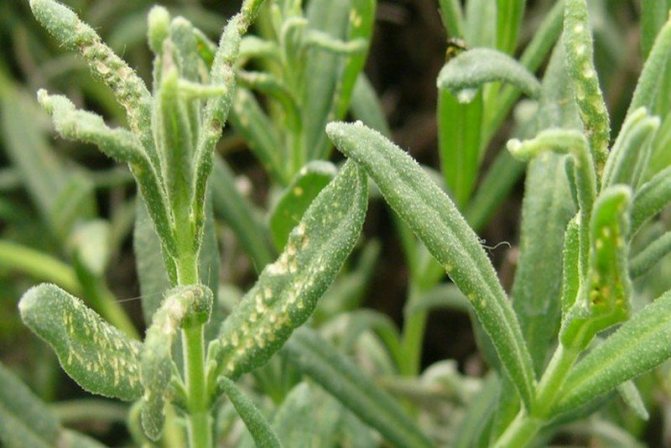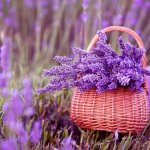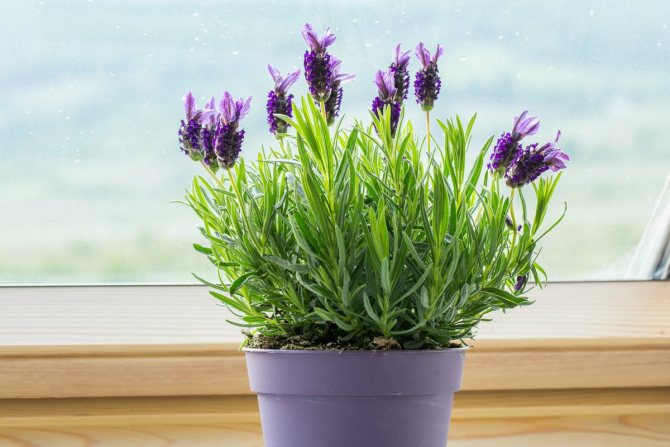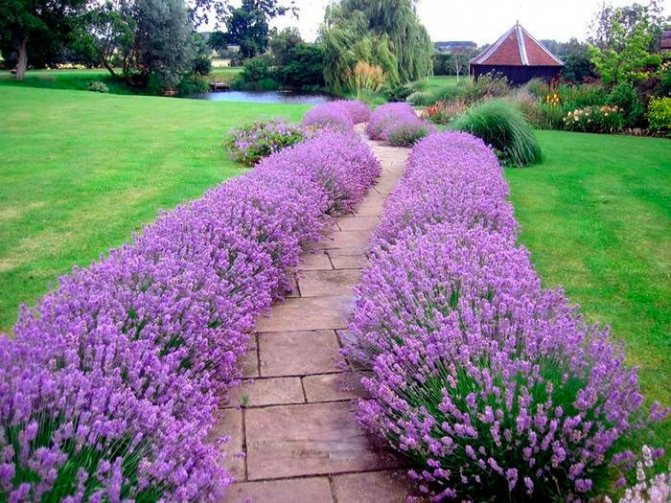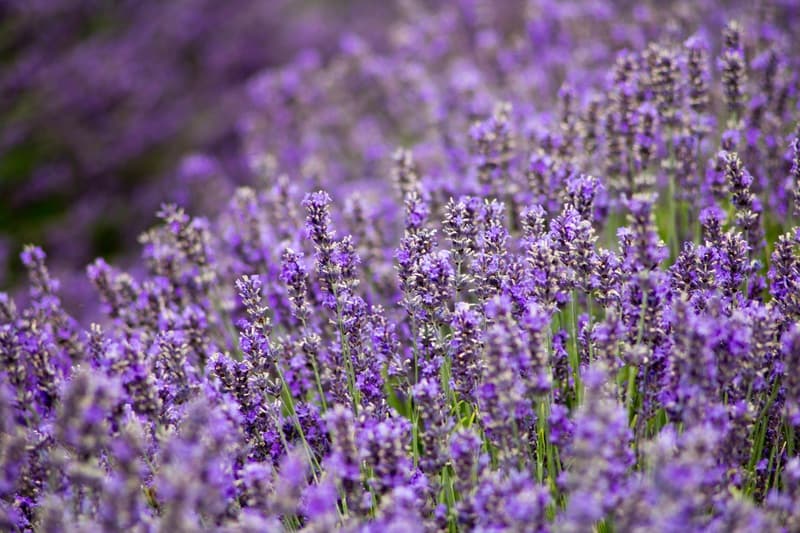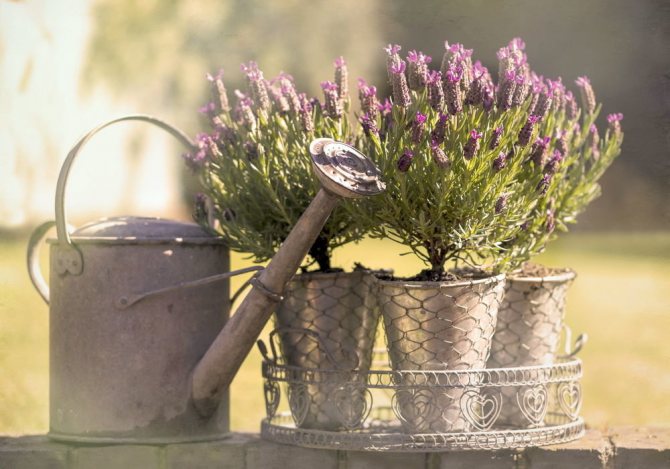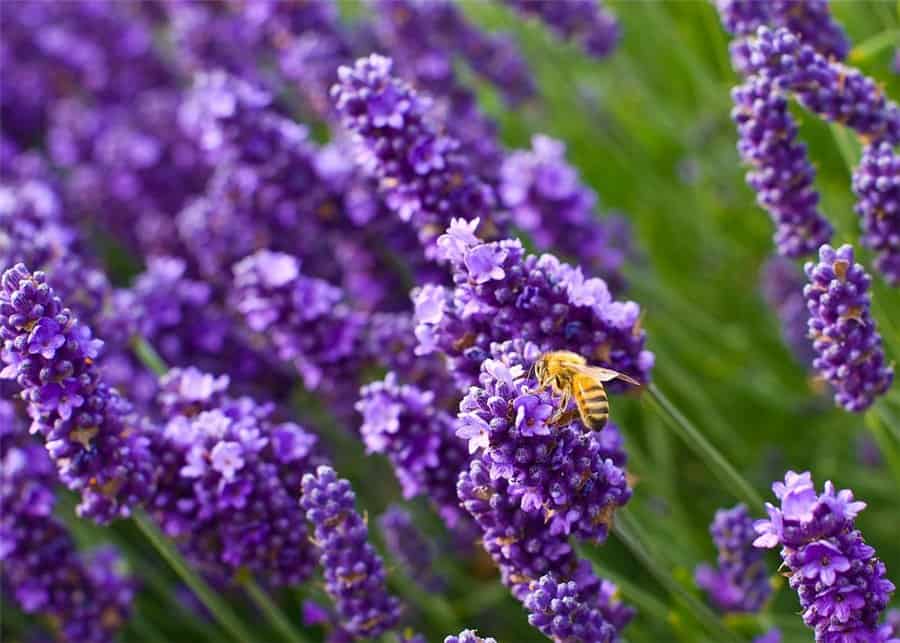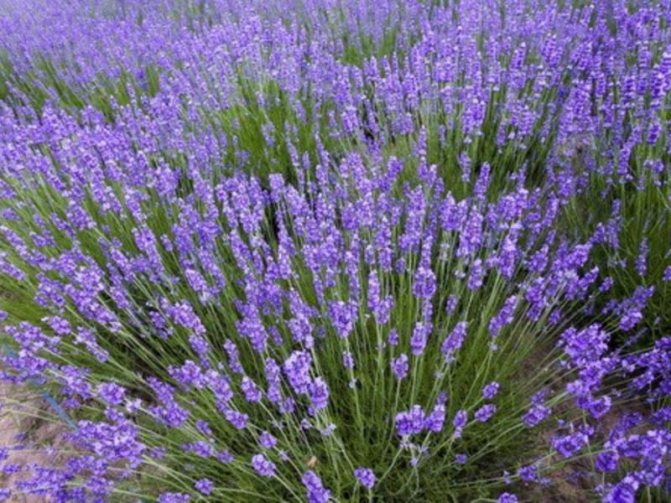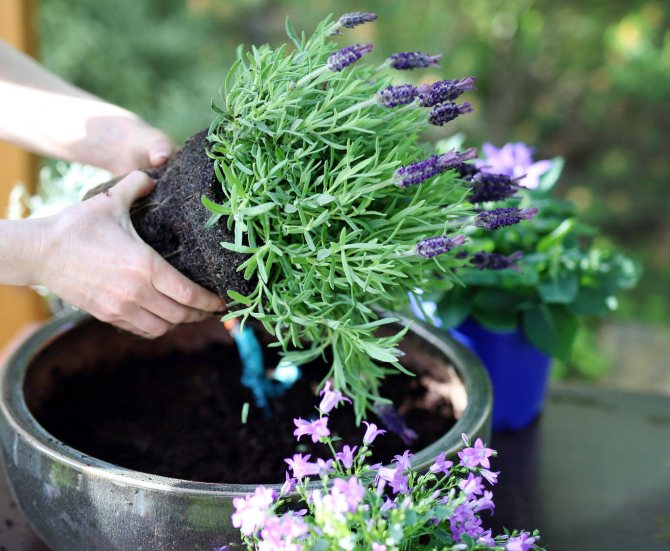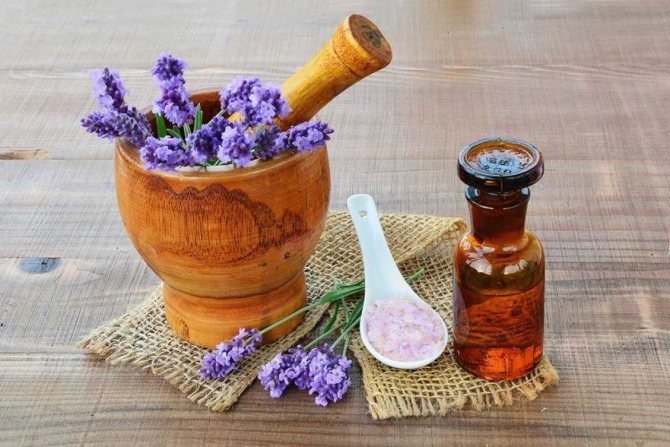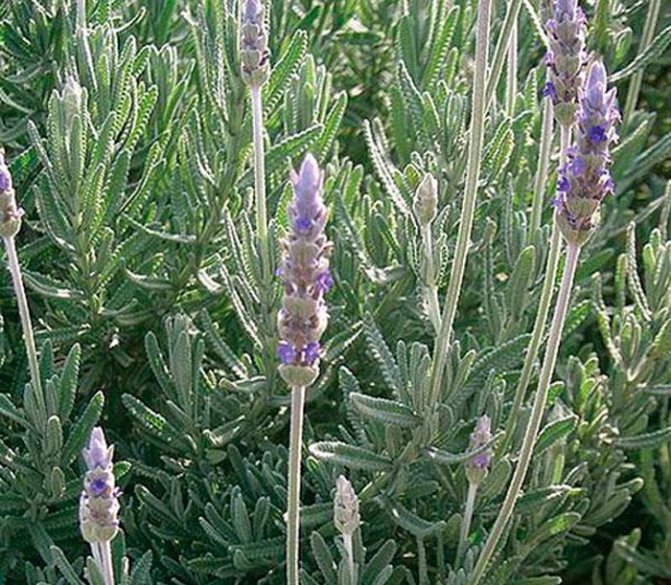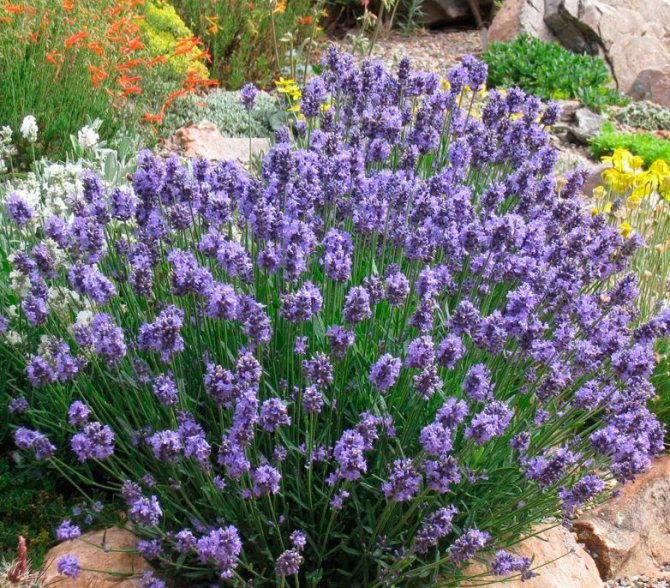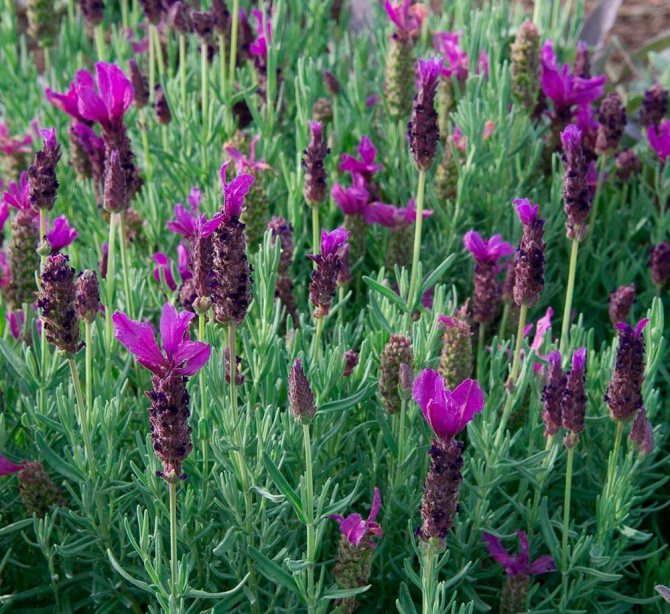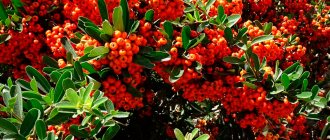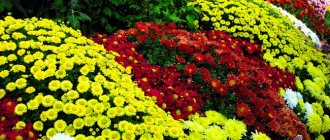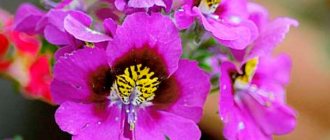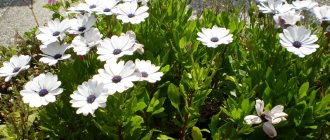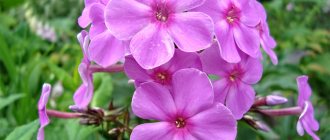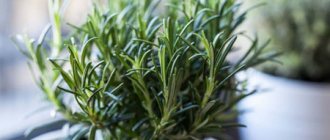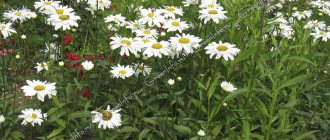Lavender
- a perennial evergreen shrub from the family of the Yaroslavl family. This thermophilic plant is widespread throughout the world. In its natural state, it grows in the Canary Islands, India, Africa and southern Europe. In the middle lane, planting and caring for lavender outdoors is a laborious task, but this plant is popular with many gardeners.
Growing lavender (lat.Lavandula) on your site is quite within the power of even a novice gardener, and a flower bed or mixborder of various varieties will create an amazing play of lilac and purple shades on your site.
The subtleties of planting and care in the open field for delicate lavender
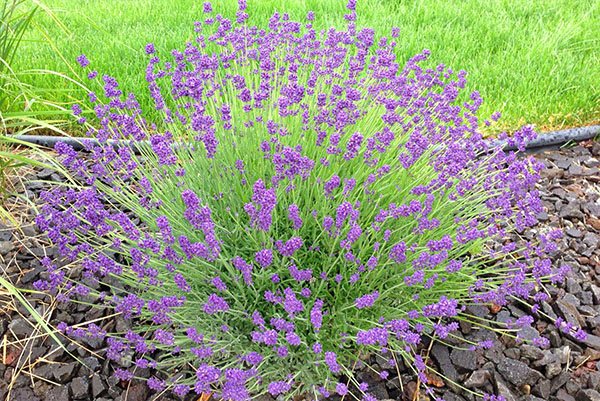
In the numerous family of Yasnotkovs, there are a lot of plants that have amazing decorativeness, an extraordinary aroma, and other useful properties. If the summer resident wants his site to be decorated with lavender, planting and care in the open field is a key moment on the path to success.
A perennial essential oil crop up to 60 cm high with spike-shaped blue or purple inflorescences has become a symbol of Provence. Lavender is grown in the Mediterranean, and in Russia it is planted in the Crimea and the Black Sea coast of the Caucasus.
Can a thermophilic plant take root in the middle lane? How to tame the culture of a gardener in Siberia or the Urals?
Among the plants related to lavender, there are many that, as a result of growing on personal plots, have completely assimilated, becoming part of the native flora. And some of them are well-known wild plants. These are motherwort and oregano, thyme and mint, catnip and lofant.
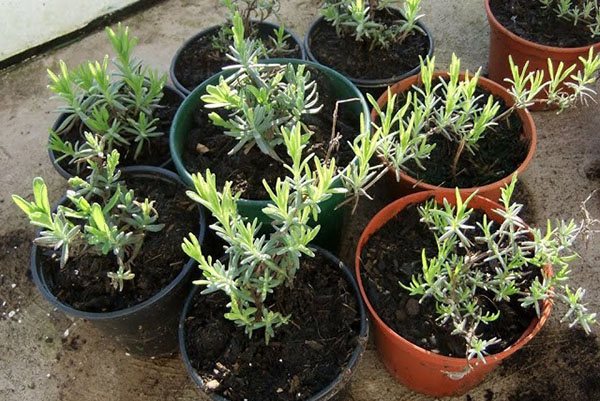

For the southern heat-loving beauty, the climatic conditions of our country are far from always comfortable. Still, planting lavender in the ground is possible. The main thing is to choose the right place, time and follow the rules of care.
Types and varieties of lavender with photos and names
To date, only broad-leaved and narrow-leaved lavender is cultivated by gardeners. Below, we will also describe those types of lavender that can also be grown in your garden.
French lavender (Lavandula stoechas)
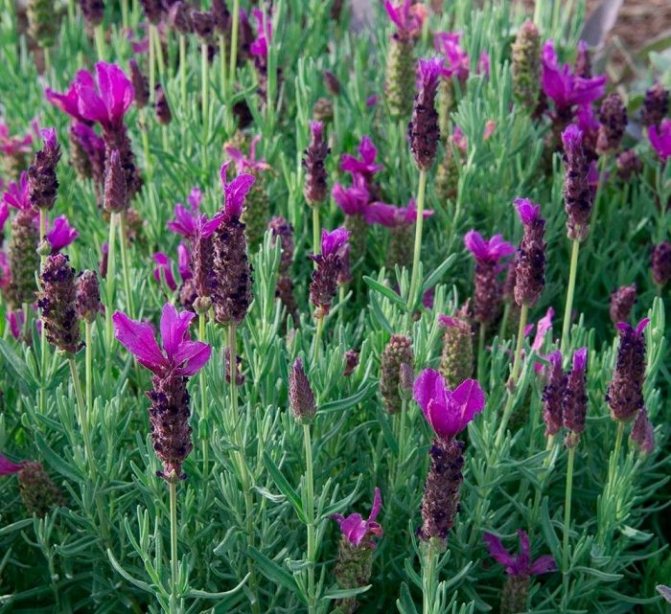

Or lavender broadleaf (Lavandula latifolia). The homeland of this species is the South-West of Europe. The scent of the spectacular flowers of such lavender is very strong, they can be painted in various shades of pink, green, white, purple, lilac or burgundy.
This lavender blooms a little earlier than other species, and this happens in April-May. Flowering ends in July, but sometimes in the last summer weeks the bush blooms again. Compared to narrow-leaved lavender, this species is not so highly resistant to frost, therefore it is cultivated mainly in regions with a warm and mild climate.
The most popular variety among gardeners is Lavandula stoechas pedunculata, or "butterfly" (Papillon): the flowers of such a shrub have an unusual spectacular shape. The best varieties of lavender are:


- Yellow Vale... The foliage of the shrub is greenish-yellow in color, the flowers are dark purple, and the bracts are crimson.
- Regal Splendur... The flowers are dark purple.
- Rocky Road... This variety has appeared relatively recently.Its large bluish-lilac flowers open in July.
- Tiara... Bracts in large blue cream flowers.
- Helmsdale... The flowers are colored burgundy-lilac.
Hybrid lavender (Dutch)
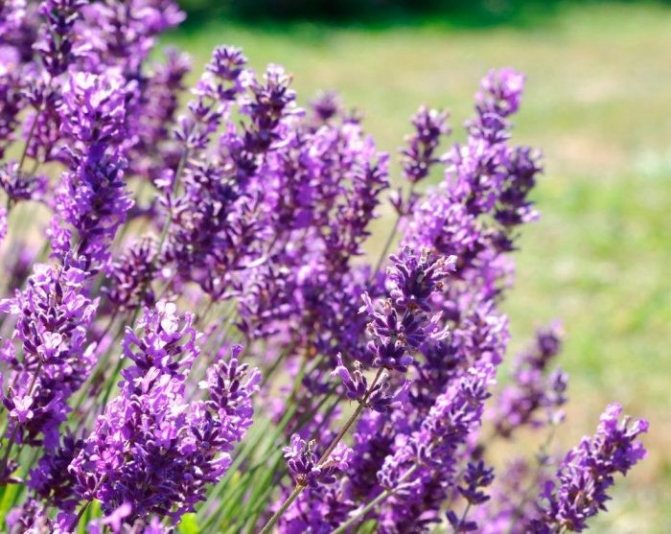

This group of hybrids, characterized by high decorativeness, was created using English lavender and other species of the genus. Such a large shrub is decorated with narrow leaf plates of a silvery color, as well as large oblong flowers, located on long peduncles, which bend under their weight. It blooms in July. The best varieties include:


- Alba... The flowers are white.
- Arabian Knight... The color of the flowers is dark purple or dark blue.
- Sawyers... The color of the flowers is pale lilac.
- Grosso... Large beautiful flowers are painted in lilac-purple color.
- Richard Gray... The compact bush is decorated with dark purple flowers.
Toothed lavender (Lavandula dentata)
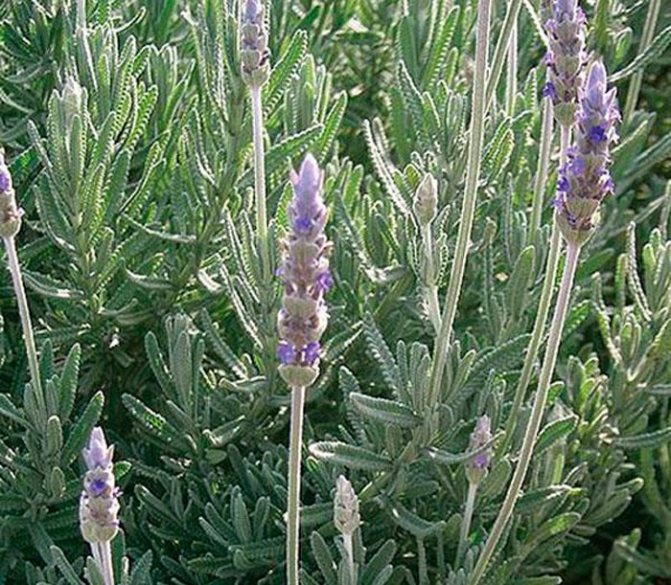

This species comes from the Mediterranean. It is a compact shrub characterized by thermophilicity. The silvery leaf plates are jagged and soft. In July, bloom is observed, during which large fragrant flowers open. The species is not highly resistant to frost. The most popular among gardeners is the variety - Royal Crown: flowers are painted in lilac color.
Narrow-leaved lavender (Lavandula angustifolia)
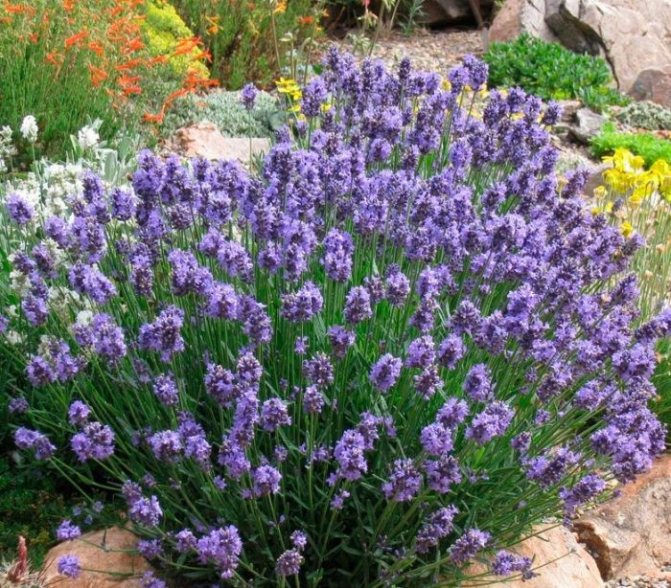

Or English lavender (Lavandula spicata), or medicinal lavender (Lavandula officinalis). The homeland of this shrub is Southern Europe. This perennial is decorated with greenish-silver foliage, as well as small lilac-blue flowers. Flowering begins in July – August. This species differs from the others in that it has the highest resistance to frost.
The most popular variety of such a shrub is dolphin-like lavender: the height of the bush is no more than 0.3 m, it is decorated with very spectacular silvery leaves. Lavender Headcoat is also widely cultivated, most often it is used to create not very high hedges. The best varieties include:


- Alba... Half-meter bushes adorn white flowers.
- Rosea... A short shrub, reaching a height of about 0.4 meters, during flowering forms mauve inflorescences.
- Manstad... The bright blue flowers bloom on a bush that reaches a height of 0.4 meters.
- Headcoat Giant... The height of such a compact shrub is about 0.6 m.
- Headcoat Blue... Violet-blue flowers adorn the compact plant, which reaches a height of about 0.4 m.
The timing of planting lavender in the ground
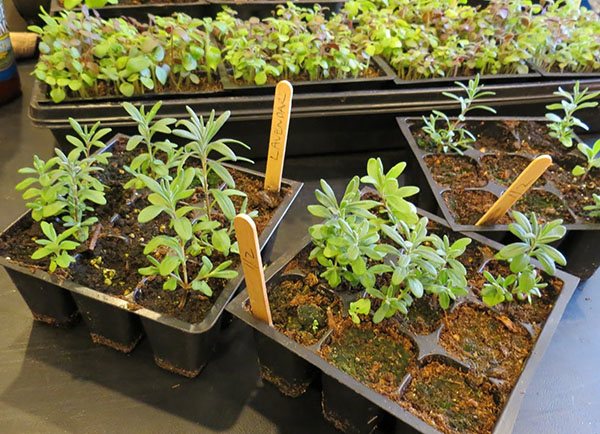

Of all the varieties of lavender, Lavandula angustifolia or narrow-leaved lavender is recognized as the most frost-resistant and unpretentious.
Under cover, it can survive frosts down to -35 ° C, which is quite comparable with winter temperatures not only in the central part of the country, but even in the Urals or Siberia.
Lavender propagates by seed and vegetatively using parts of an adult bush, rooted cuttings or cuttings.
In the first case, like many other decorative perennials:
- at home, medium-sized seeds are sown for seedlings in early spring;
- when stable heat comes, you can sow seeds in the beds;
- planting lavender in the ground in the fall is carried out to obtain plants for next year.
Vegetative reproduction helps to bring flowering closer. In this case, seedlings with their own root system fall into the soil in the second half of summer or autumn. Specific dates directly depend on climatic and weather conditions.
In the middle lane, lavender planting in open ground and caring for it obey the rules common to all regions. The seeds should fall into the warmed-up soil when the sprouts are not threatened by spring frosts.And before that, in order to accelerate germination, they are stratified in a refrigerator.
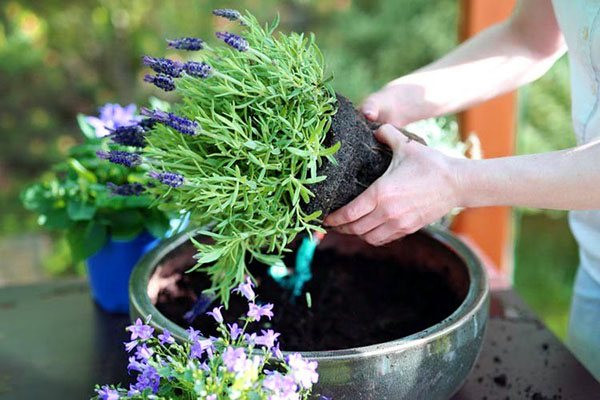

In the central part of Russia, such conditions for sowing develop by the second half of May. In the regions to the north and east, the soil warms up even later. Unfortunately our summer is short for lavender. Seedlings very often die without surviving the winter. Therefore, planting lavender in open ground in the Urals, for example, is preferable to seedlings obtained as a result of winter or early spring sowing, or seedlings obtained from an adult bush.
When and how indoor lavender blooms
When lavender blooms
Shrub flowers form in June. The plant can continue to bloom until autumn, more precisely until October. During flowering, the plant blooms flowers. From them inflorescences are obtained, turning into spikelets. Each spikelet contains 6-10 buds.
The shape of the leaves of each species can be different. It is worth adding to the above types of shrubs:
- monsted, whose purple inflorescences rise above the stem;
- hidkot, which has strongly branching shoots and large flowers of a blue-violet hue;
- southerner requiring stratification for growing at home;
- stekhad, which has inflorescences of such shades as white, cherry, lilac, purple and green;
- butterfly with flowers of blue, lilac and dark purple shades.
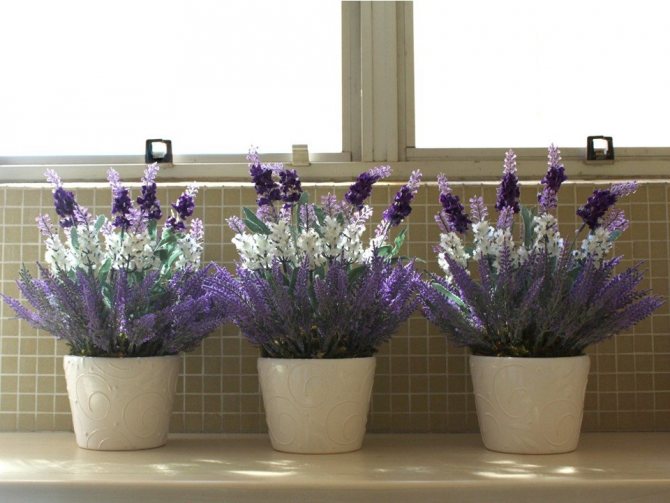

Flowering lavender
Planting lavender seedlings in the ground
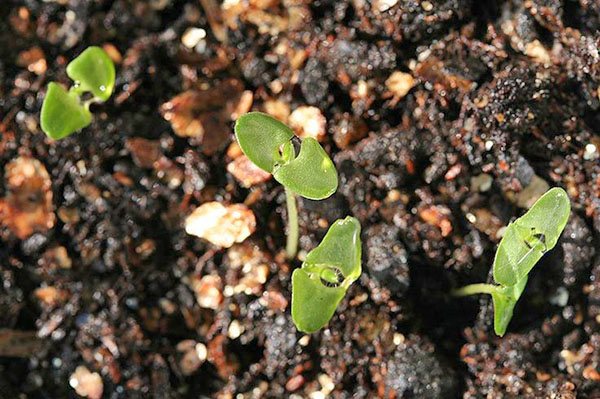

At the end of February or in March, when the period of stratification ends, seeds are sown on the surface of a mixture of fertile garden soil and sand. It is useful to pre-sterilize the substrate and sort out large inclusions.
The crops are sprinkled with a thin layer of sand and placed in a home greenhouse. Germination takes place in the light at a temperature of 17–22 ° C. To maintain moisture, the soil is periodically sprayed with warm water, and to avoid the appearance of mold, the container is ventilated. The first shoots should be a signal that the plants need additional lighting. When the seedlings get stronger, they are dived, seated at a distance of 5 centimeters.
It is convenient to use peat pots before planting lavender in the ground. In them, the plants develop well, their roots are protected from decay and do not suffer during transfer to the garden.
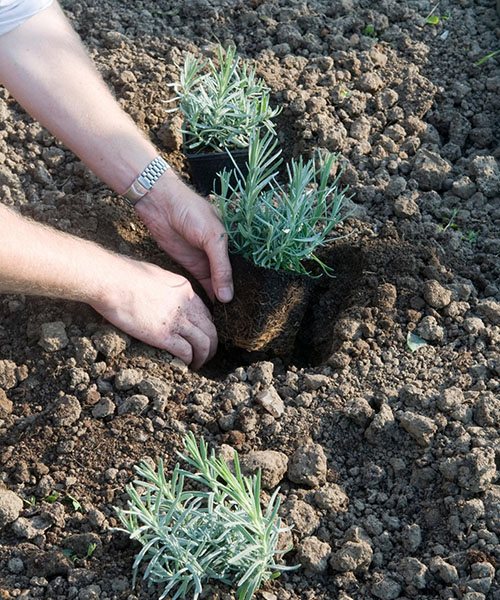

At the end of May, it is time for planting in the ground and caring for lavender in the Moscow region. For plants, choose dry, ventilated and well-lit places, the soil on which has a pH level of no higher than 6.5-7.5. The site is dug on a bayonet, simultaneously bringing in peat, humus and, if necessary, dolomite flour, loosening the ground.
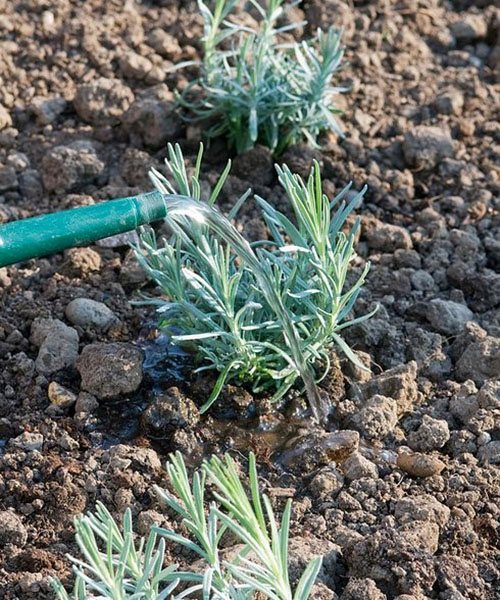

Seedlings are carefully transplanted, leaving at least 70-90 cm of free space between the plants, it will definitely come in handy for the growing bushes. During planting, the tillering point is slightly deepened, then the soil is compacted and thoroughly shed.
Autumn sowing of lavender is practiced only in the southern regions, where the seeds do not freeze, and immature sprouts can, without fear of spring cold, immediately grow. After planting the seeds in the ground, the beds are watered, and with the first frost they are abundantly covered with snow.
How to grow on the window correctly
To achieve success in plant cultivation, it is worth adhering to the basic recommendations.
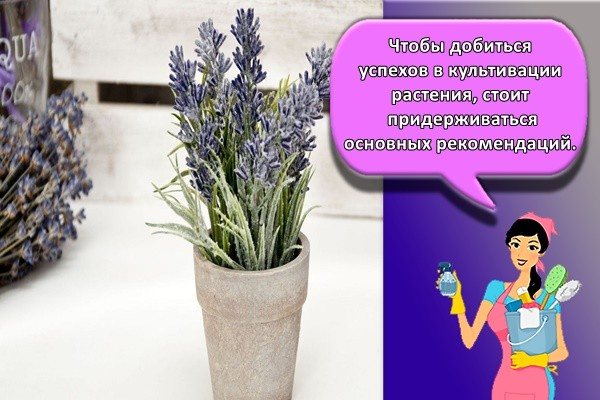

Pot selection criteria
Mature plants have a strong root system that nourishes flowers and leaves. To ensure her full development, you should choose the right pot. It must have a volume of at least 2 liters and a diameter of at least 30 centimeters.
It is important that the container contains enough holes to drain moisture out.
Soil selection
Lavender loves alkaline soil, which contains a lot of sand. The pH value is of no small importance. It should exceed 7. When preparing the soil yourself, it is worth taking sand, garden soil and peat in a ratio of 2: 2: 1.It is not recommended to use too much peat, as it leads to strong acidification of the soil. For lavender, you can purchase ready-made cactus soil. It has a pH of 7.5-8 and contains vermicompost, sod soil and ceramic chips.
Landing
To plant lavender, it is worth choosing the right breeding method. The plant can be planted by seed. It is also permissible to use layering or cuttings. It is best to plant seeds. This method is considered the most affordable.
Planting lavender in the ground with cuttings, parts of a bush and layering
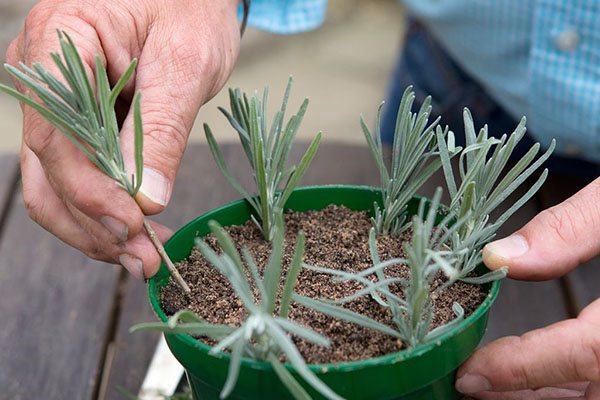

If there is an adult plant on the site, you can:
- divide it, getting seedlings with growth points and a root system;
- get cuttings that, after rooting, are easy to plant in the ground;
- create conditions for the formation of stem layering.
The lavender bush intended for dividing is carefully spud before wintering, and the shoots are cut off at a height of 10 centimeters. In spring, hilling is repeated, stimulating the formation of young shoots. A bush prepared in this way is dug up in the fall and divided into independent parts. They immediately plant lavender in the ground, in the fall the plant has time to acclimatize and prepare for winter.
In spring and summer, lavender shoots are used for cuttings. 8-10 cm pieces of stems are planted in wet sand, deepening by 2-3 cm. In the greenhouse over the summer, cuttings form roots. With further home care for lavender, planting it in open ground is carried out in May or early June.
To obtain layering, selected strong shoots in the spring are tilted to the ground and buried in, fixing with a metal hairpin at a depth of several centimeters.
During the summer, the cuttings are looked after by weeding the soil nearby and watering the root formation sites. In the fall, such seedlings are separated from the mother bush and planted in a permanent place in the garden.
Lavender properties: harm and benefit
Medicinal properties of lavender
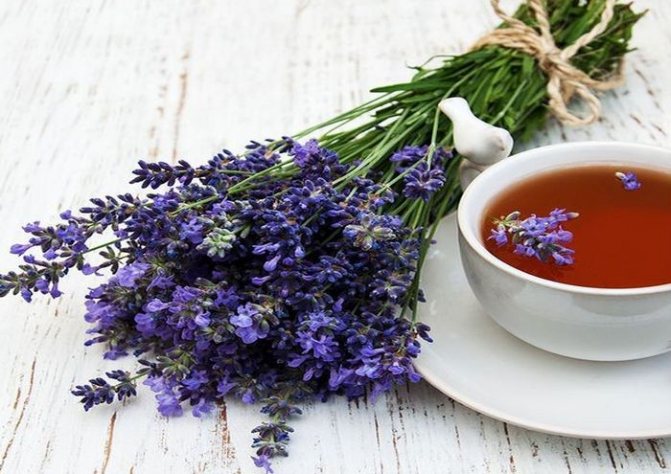

Lavender has an essential oil in all aerial parts; it contains linalool, coumarins, ursolic acid, tannins, geraniol and borneol.
Lavender oil is very useful, due to this it is widely used both in medicine and in the perfumery and cosmetic industry. This oil is used to treat bruises and burns.
Lavender is also used in the treatment of cerebrovascular diseases, seizures and paralysis after a stroke, and it can also help with dizziness, headaches and drowsiness. The culture is distinguished by its diuretic effect, and it is also able to eliminate toothache. Tea with this plant is used to relieve stomach discomfort and cramps.
It can also help with melancholy, irritability, hysteria and neurasthenia, as well as with flu, asthma, bronchitis, whooping cough, tuberculosis, enteritis, flatulence, atony of the gastrointestinal tract, worms, rheumatism, cystitis, amenorrhea, hypertension, fever and various rashes ...
Experts note that lavender infusion has a positive effect on the human nervous system as a whole, as well as on his general mental state. It helps to eliminate stress, as well as to reduce the negative impact of adverse factors on the mental state and consciousness of a person.
It was also noticed that the infusion promotes the stimulation of mental activity and the rapid restoration of energy and strength.
Lavender foliage is used for the preparation of healing baths, and dried inflorescences are used as an effective anti-moth remedy when storing clothes, and also as a fragrance for linen and room.
Contraindications
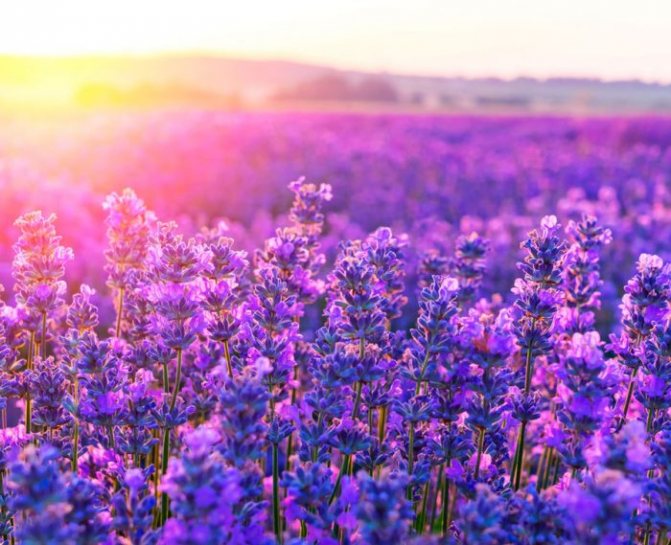

Lavender oil should not be used by pregnant women, especially in the early stages, because lavender helps to stimulate the contraction of the muscles of the uterus. It is also forbidden to use it after an abortion, as in this case it can cause bleeding.
Also, lavender cannot be used simultaneously with preparations that include iodine or iron. Prolonged use of the oil can cause depression and irritation of the gastrointestinal mucosa.
Products made on the basis of lavender have a powerful effect, and therefore can cause a severe allergic reaction. In this regard, before using such a drug for the first time, it is imperative to consult with a qualified specialist.
P.S. Do you like the idea of growing lavender at home? Click on the "Like" button and share with your friends!
P.P.S. Subscribe to the magazine community
Taking care of lavender after planting outdoors
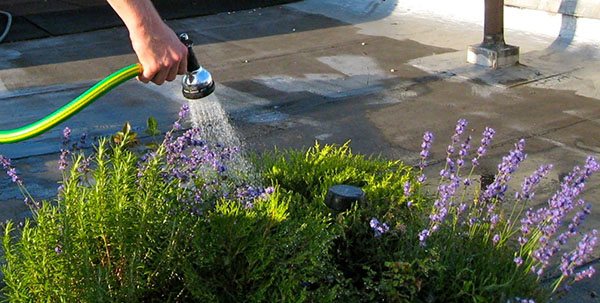

Lavender is planted for its fragrant blue-purple flowers. But on young plants in the first year of life, all the buds are cut off without waiting for flowering. This will strengthen the open field planting of lavender and make it easier and more effective to care for them. Throughout the life of the bushes, they must be weeded and watered.
Lavender is a hardy crop, but it needs moisture to bloom. In hot weather, watering should be abundant and frequent.
Adult bushes form a dense dense cushion on the surface of the soil. It is problematic to loosen the soil under them, but it is very important to keep the area around them clean. A layer of peat mulch will help to save moisture and airiness of the soil.
Spring-autumn hilling helps to maintain the crown density. It stimulates the formation of young shoots, gradually replacing aging branches. Pruning plants serves the same purpose. It is carried out after flowering and during it. For bushes aged 7 to 10 years, anti-aging pruning is recommended. During work, all shoots are shortened to 5 cm in length.
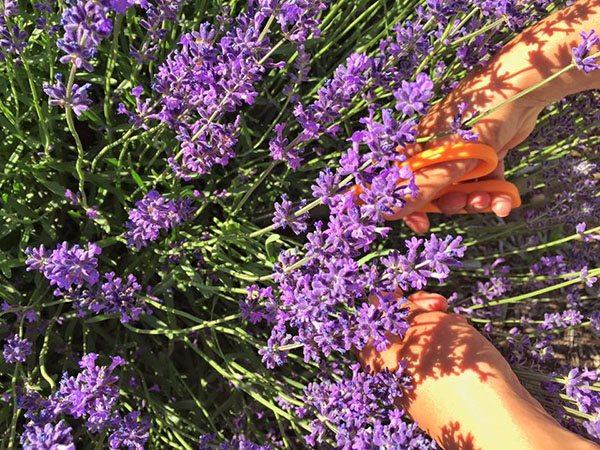

To fertilize lavender, mixtures with a predominance of potassium are used, which stimulates the formation of buds. Nitrogen is applied in moderation in the spring.
Southern crops, including lavender in Russian conditions, are at risk of freezing. To prevent this from happening, the bushes before frost are covered with spruce branches, non-woven material or other breathable types of protection that allow air to pass through, and then sprinkled with abundant snow.
Video about amazing lavender
Popular bugs
Landing on heavy clay soils, in lowlands.
Lavender should be planted on a hill, in a lighted area, and away from water sources. Excessive moisture in the soil leads to root rot.
Lack of summer pruning.
Summer pruning is optional after flowering, but it will allow the lavender to bloom again after 15 to 20 days.
Excessive watering.
Lavender prefers infrequent watering. From excess moisture in the plant, growth slows down, the leaves begin to turn yellow. If you accidentally "flooded" the plant, be sure to loosen the soil so that moisture does not stagnate at the roots.
Lavender: features of planting and care in the open field
If lavender is chosen for breeding, planting and care in the open field is not a big problem, since the plant is considered picky. Even a beginner can handle this. The main thing is to follow the basic rules.
Lavender is an evergreen perennial, its root becomes woody. It can grow to a depth of 2 m. The shrubs are known for their bluish or purple buds with a pleasant, soothing scent. Flowering usually begins in July. This is a melliferous plant. The seeds have very good germination, so that even after a few years they will be able to germinate.
There are many varieties of lavender. The most popular are the following:
- Lavender toothed. Her homeland is the Mediterranean. The culture is considered to be thermophilic. The inflorescences are very large and fragrant. The leaves are jagged and silvery. The most popular subspecies is considered to be Royal Crown, which has purple inflorescences.
- French. It is also known as broadleaf.The homeland is the southwestern part of Europe. The aroma is very strong. Inflorescences are purple, lilac, pink, burgundy, white and even greenish. It usually blooms from mid-spring to mid-summer. But closer to autumn, a sudden second flowering may begin.
- Hybrid. Also known as Dutch. This is a whole group that includes the varieties Alba, Sawyers, Arabian Knight, Richard Gray, Grosso.
- Narrow-leaved. Also called English. This also includes several subspecies: Rosea, Highcoat Blue, Highcoat Giant, Munsted and others. Their height ranges from 40 to 60 cm.
There are other interesting varieties as well.
What varieties of lavender are suitable for the Moscow region
In the Moscow region and Central Russia, only English lavender takes root well. This is the name for a whole group of narrow-leaved lavender.
Outwardly, this plant looks like this:
- Compact shrub about 60 cm;
- Many shoots (up to 300 - 400);
- Branched roots;
- Narrow neat gray-green leaves;
- Inflorescences are elongated, similar to an ear and consisting of many small flowers;
- The color is uniform - purple, blue, rarely pink.
Of the varieties worth paying attention to, it can be noted Hydcote, Southern Woman, Lilac Mist, Dwarf Blue, Ascension, Blue Expanse, Elegance, Narrow-leaved, Delight.
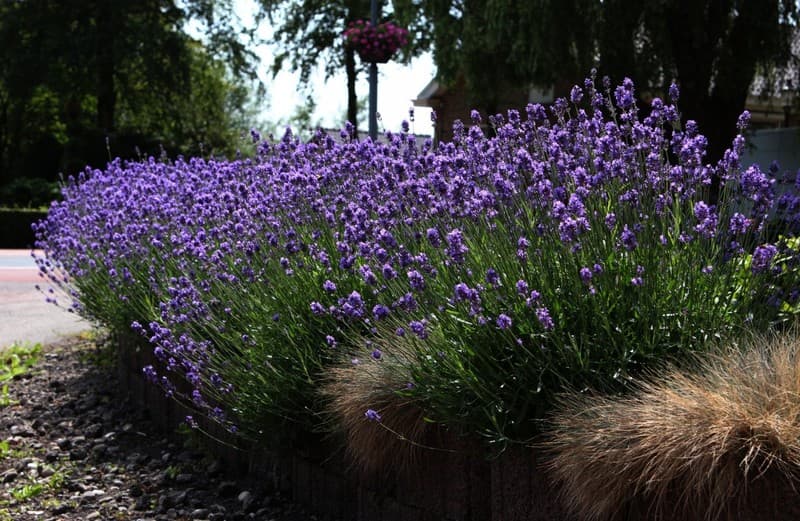

Lavender Hydcote
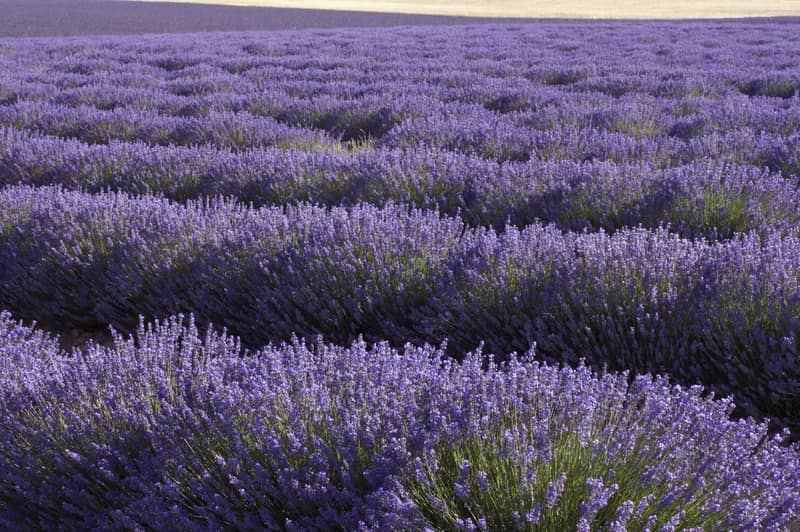

Lavender Dwarf Blue
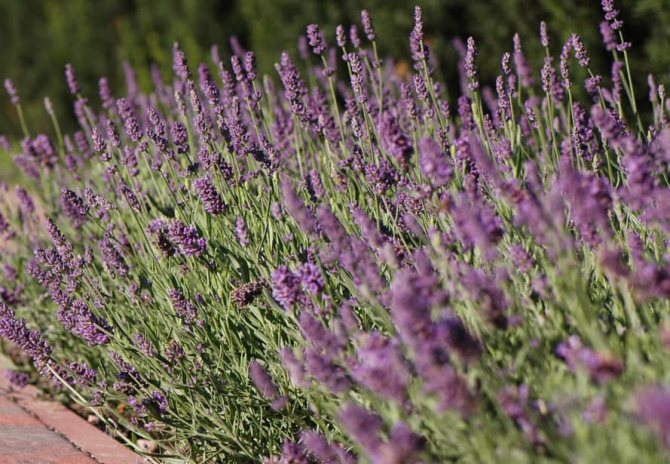

Lavender elegans
English lavender is the only one capable of withstanding Moscow frosts and temperature changes. For example, Spanish lavender can hardly tolerate these conditions and can only survive in nurseries with close attention and regular care in winter. And the French can only be grown as an indoor flower. Varieties are great for this. Rocky Road and Snowman.
REFERENCE. English lavender blooms in the first half of summer, in June and July.
Germinating seeds
It is recommended to plant lavender seeds outdoors in October. But in May, it is already supposed to transplant sprouts into the ground. To grow this plant, it is best to purchase seeds in winter or autumn time, since before sowing them into the ground, stratification is required for 2 months at a temperature of 5 ° C. This will increase the germination rate. Usually, seeds are mixed with wet sand in a cool place, for example, a vegetable drawer in the refrigerator will do. It is supposed to plant seeds for seedlings in March or late February.
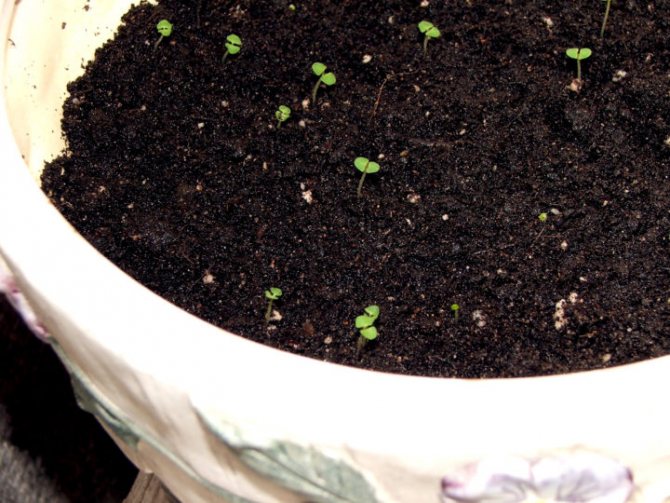

Planting and first shoots
While the seeds are in the refrigerator, you can start preparing containers in which the seed will germinate. It is necessary to take seriously the choice of soil. It is best to mix 2 parts of humus and 1 part of river sand (coarse fraction). The mixture must be sieved, since the seeds themselves are small, so the substrate should not be lumps. Then the soil mixture is supposed to be processed in the oven - the temperature should be 120 ° C. Instead of roasting in the oven, you can treat the mixture with potassium permanganate. After that, you can lay out the drainage in a container, and then add the substrate.
In the last weeks of winter or at the beginning of spring, you need to sow the seeds of the plant into the substrate, then sprinkle with a thin layer of sand (thickness - no more than 3 mm). Then sprinkle with water from a spray bottle and cover the container with cling film to make a mini-greenhouse. Glass can be used instead of film. Then put the pots in a warm and bright place. It is periodically required to open the container for ventilation. For germination of seeds, a temperature of +15 .. + 22 ° C is required.
Many people wonder when and how to plant lavender correctly. In places where winters are warm, it is best to immediately sow seeds in open ground. This method does not work in the Urals. This should be done in October, when the soil on the site is fully prepared. It is recommended to dig it up and add peat. If the soil is very wet, it is recommended to add sand or fine gravel to increase air and water permeability.This is followed by a revision of the lavender seed and immersion of the suitable material into the soil to a depth of about 4 cm. After that, the soil should be slightly compacted. If the weather is very dry in autumn, it is recommended to water the crops, but there should not be too much water. When it snows, you need to make a small snowdrift on the site.
Pros and cons
When deciding to grow lavender, you should familiarize yourself with the main virtues of the culture. The plant has a pleasant scent that has a calming effect and relieves headaches. Lavender has many beneficial effects. An essential oil is made from flowers. It is used in medical practice, cosmetology, and the perfume industry.
The oil is often used to fight burns. It helps to relieve joint pain. Also, the composition is used for massage. It helps relax muscles and relieve tension. The composition has a strong antimicrobial effect. The plant has practically no minuses. The only drawback can be considered an individual intolerance to the aroma of culture.
Seedling care and planting in open ground
When germinating seeds for seedlings, as soon as the first shoots appear, you need to think about lighting. It is necessary to additionally install phytolamps, otherwise the sprouts will be too elongated. Every day, the film or glass must be removed for a certain time so that the sprouts get used to room temperature. When they are fully adapted, the cover can be completely removed. After that, plant the sprouts so that 5 cm remain between them.
In May, you need to plant seedlings. Lavender in the garden will look good. It is usually used to decorate rock gardens. You can plant it on the sides of a path or curb.
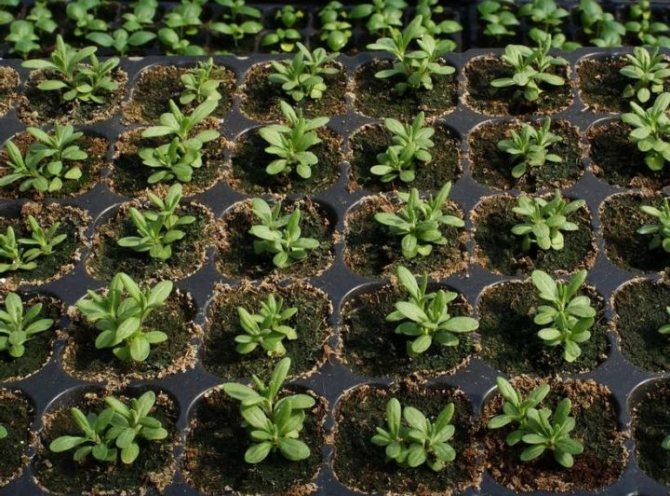

Lavender will grow well under the bright sun. But in wetlands, it should not be planted. The same applies to places where groundwater is high. Lavender is very susceptible to too much water, so these conditions will not work for her.
It is best to choose dry soil. Sandy loam is perfect. The plant also looks good in loamy soil, but good drainage should be done. The acidity level should be in the range of 6.5-7.5 units. If the soil is too acidic, then additional ground limestone is required. Before planting seedlings in open soil, it is necessary to dig it to a depth of at least 25 cm, loosen it thoroughly and add compost or peat in parallel.
Lavender is planted at a distance of 80 cm from each other, and if the plant is tall, then it is required to retreat until the next bush 130 cm. The hole in depth should be such that all the roots can fit into it without deforming them. Before planting, it is better to trim the roots a little. Then you should install the bush in the hole and bury it. To deepen the root collar by 5 cm. Then pour everything thoroughly.
Brief description of cultivation
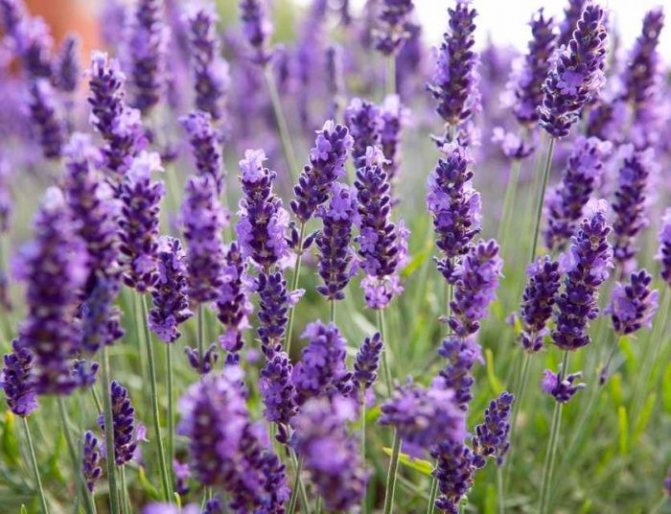

- Landing... Seeds are sown on seedlings in February – March, in open ground - in October, while seedlings are transplanted into open soil in the last days of May or in the first days of June.
- Bloom... It starts in the middle of summer.
- Illumination... Needs lots of bright sunlight.
- Priming... It should be dry, water and air permeable, loamy or sandy with a pH of 6.5–7.5.
- Watering... Lavender should be watered regularly and abundantly. During a long dry period, the frequency of watering is increased.
- Fertilizer... Top dressing is carried out twice during the growing season. In spring, a complex mineral fertilizer with an increased nitrogen content is introduced into the soil, and in the fall - phosphorus-potassium fertilizer.
- Hilling... Old plants need to be hilled high twice a season, they do this in spring and autumn.
- Pruning... When the bush fades, all the inflorescences are removed from it, and in the autumn, the branches are shortened. After the plant turns 10 years old, it is rejuvenated, for this, all branches are cut off at a height of 50 mm from the soil surface.
- Reproduction... By seed method, as well as cuttings, layering and dividing the bush.
- Harmful insects... Cicadas, rainbow beetles and aphids.
- Diseases... Gray rot.
How to care for lavender in the garden?
Real professionals carefully care for lavender, but a beginner gardener can also handle this work. The main thing is to know some of the features. As soon as the first inflorescences appear on the seedlings, it is recommended to cut them off so that the lavender flower does not waste its resources on flowering and gains strength, strengthens the root system.
Growth will be very slow in the first year, so you will have to devote a lot of time to weeding to remove the weeds, otherwise they will drown out the seedlings. Watering should be abundant and regular, especially on hot days. After that, you need to loosen the soil. The same goes for rains. After watering, additional weeds should be pulled out. To avoid all these procedures, you can simply use mulching between the bushes, for this you need peat.
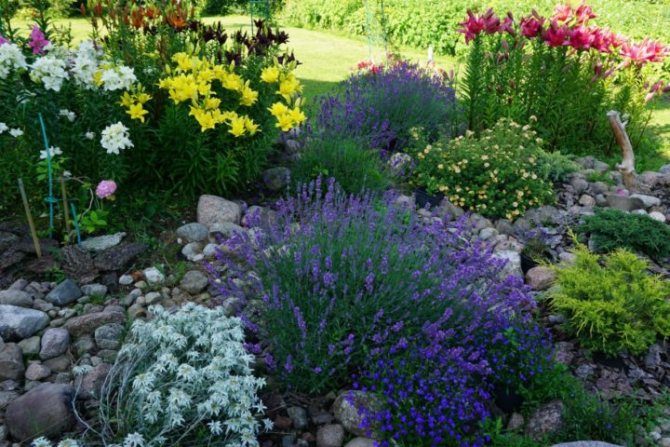

Lavender as an ornamental plant
In spring and autumn, old bushes should be hilled. This prevents new shoots from appearing on the branches. In addition, fertilization is required to the soil. It is best to choose those that contain potassium. But nitrogen-containing fertilizers and manure will only provoke the growth of the bush, the appearance of new shoots. All the strength of the plant goes to the greenery, but flowering never comes.
Lavender in the Leningrad region is also capable of growing, as in Moscow, the Moscow region. But for such areas, only the English lavender variety is suitable. It is also called medicinal or narrow-leaved. If such lavender is chosen, planting and care in the Moscow region will be carried out according to the same principles as in the warm regions of the country. It is necessary to sow seeds in the ground when there is no threat of frost. This is approximately the second middle or end of May. But the seedlings are supposed to be planted in June. In autumn, it is not worth sowing seeds for the winter, as there is a high probability that they will simply freeze.
If in the region where this crop will be planted, the winter temperature is below -25 ° C, it is recommended to additionally protect it from frost. But you cannot use fallen leaves for warming, since under them the plant itself will simply rot. It is best to cover the shrub with spruce branches after pruning in the fall. If the winter is not too cold, then narrow-leaved lavender may not be covered.
As for pests, the shrub is resistant to both them and diseases. However, no one is immune from problems. Sometimes the plant can be affected by leafhoppers and rainbow beetles. As for diseases, the most common is gray rot.
You will have to remove beetles and leafhoppers with your hands. After that, you need to change the layer of mulch. As for gray rot, it appears only due to constant waterlogging of the soil. For example, heavy and frequent watering or constant rainfall may be the cause. It will no longer be possible to cure the plant. It is supposed to be removed, and then completely burned, otherwise the infection will begin to spread to other shrubs.
Possible problems in growing indoor lavender
A shrub may stop growing if its root hits the bottom of the pot. It is recommended to select deep pots for planting. The room in which the plant is grown must be constantly ventilated. Growth will slow down in a stuffy room. You can ventilate the plant on the balcony.
Do not overdry the soil. The plant should not dry out, otherwise nothing will help it. Excessive moisture can lead to gray mold. In this case, the stems begin to fade.If the shrub is affected by gray rot, it is recommended to transplant the plant.
If you follow all the rules of care and provide this picky plant with the proper conditions, it will respond to care with beautiful flowering and a pleasant aroma.
Reproduction and pruning of lavender
If there are already lavender bushes on the site, then you can propagate it by cuttings. Also, this method is suitable for those who managed to find somewhere a one-year-old shoot that has already become numb. It is supposed to be cut. The cuttings should be 8 to 10 cm long. Then they should be planted in wet, loose soil. The cut is supposed to be deepened by 3 cm. Then cover with a glass jar. When the roots appear at the cutting, you can remove the jars.
There is another breeding method - by dividing the shrubs themselves. To divide the bush, you need to prepare it first. In the autumn, after the bush has faded, it must be cut off, leaving only 10 cm. Hilling is also required. All the space between the shoots must be filled with soil. In the spring, the hilling procedure should be repeated. Abundant growth is formed over the summer. In autumn, the bush can be dug up and divided into several parts, and both the shoots and the root system will be well developed.
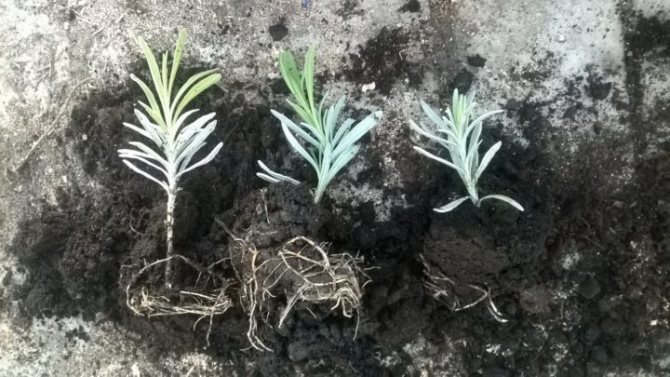

Reproduction by dividing the bush
There is a third method for propagating lavender - it is to use layering. Perform the procedure in the spring. Several shoots need to be folded back and placed in a pre-dug groove. Its depth should be no more than 4 cm. The shoots should be fixed in this position, sprinkled with soil and watered. Throughout the summer, you need to ensure that the soil in this place where the layers are located is wet. Next spring, shoots, on which roots have already formed, need to be separated from the mother bush and transplanted to a permanent place.
Another important procedure is pruning lavender. This procedure will have to be carried out every year. As soon as the flowering of the shrub ends, it is necessary to cut off all the wilted inflorescences. In autumn, the branches themselves should be shortened. This is required in order to maintain the beautiful shape of the shrub.
The lavender should not be allowed to become too elongated, since due to the strong wind, the bushes can bend to the ground, which is why their decorative effect is lost. When the bush is more than 10 years old, it is recommended to rejuvenate it by pruning. All branches should be shortened to 5 cm. The same can be done with young shrubs, if you cannot get them to bloom abundantly.
Lavender pests and diseases
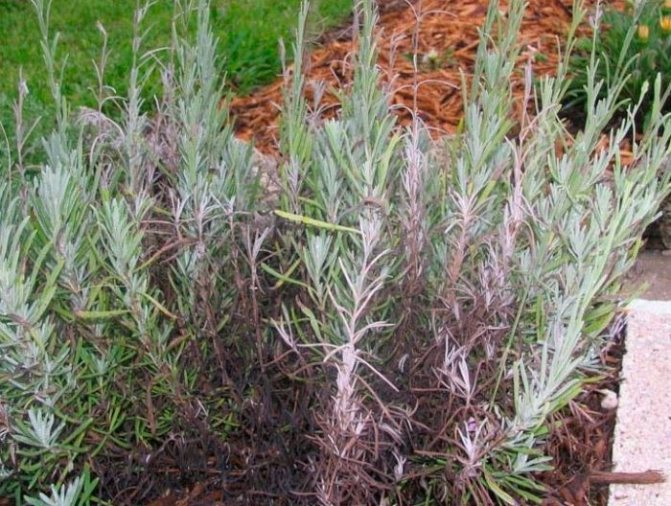

When grown in open soil, lavender is very resistant to harmful insects and diseases. However, problems can arise with it. In some cases, the shrub is affected by gray rot or rainbow beetles or slobbering pennies (leafhoppers) settle on it.
If pests have settled on the bush, then you can get rid of them by collecting insects by hand. Then be sure to replace the mulching layer under the bush. The development of gray rot is facilitated by the regular stagnation of liquid in the soil, which can be caused by excessively frequent and very abundant watering or prolonged rains.
Such a disease cannot be treated, so it is recommended to dig up the affected bush and destroy it. If the disease is at the initial stage of development, then you can try to save the lavender, for this, immediately after detection, all affected parts of the bush are cut out. And then the irrigation regime is necessarily corrected.
Lavender planting and care in the open field of the Moscow region and the middle lane
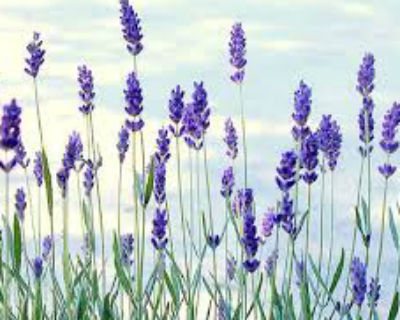

A very pleasant smell came from the neighboring front garden, it turned out that the neighbor was growing lavender, planting and caring for it in the open field, as I found out, couldn't be easier. So I also got fired up with the idea of planting this plant in my home.
This dwarf shrub of the family is a relative of thyme, mint, rosemary.It grows mainly near the Mediterranean Sea, there are about 28 types of lavender. Many are used in the perfumery industry, for the manufacture of perfumes, soaps, and toilet water.
- 1 Description of the plant 1.1 Varieties of lavender
- 2.1 Landing 2.1.1 Landing site
- 2.2.1 Watering
- 2.4.1 How to grow lavender from seeds, video
How to deal with pests
Lavender is practically unaffected by insect pests. This is due to the fact that its stems and leaves contain a large amount of essential oils.
Occasionally, leaf beetles and spider mites can be found on lavender. But usually there are very few of them. However, if you carry out pre-planting treatment with insecticides, then there will be no pests at all.
Of the diseases that the plant is susceptible to, gray rot can be noted. But this disease is not cured in any way. A diseased bush must be dug up and burned away from other plants. Gray rot is a consequence of improper care of lavender. Especially often it occurs due to the wrong watering regime of the plant.
Description of the plant
A half-shrub about a meter high, of a greenish-steel color, looks very decorative. Narrow leaves, up to 5 cm long, are covered with silvery hairs. Purple flowers are collected in terminal inflorescences, blooms from late June to mid-August.
Even when dried and processed, the plant retains its divine aroma. If you keep a sprig of lavender in the closet, the linen takes on a long-lasting pleasant smell. No wonder the French are interested in this plant. After all, what kind of products are there with the scent of lavender. All famous perfumery companies use essential oils for fragrances of various creams, gels, scrubs.
Varieties of lavender
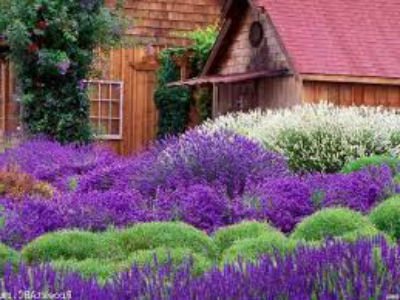

There are a little more than 25 types of lavender in nature, but we grow only a few species in our gardens.
- English lavender (narrow-leaved) is an unpretentious variety with a compact bush no more than a meter in diameter. Leaves are gray-green, narrow, elongated. The flowering period is from June to July. The variety is frost-resistant.
- French lavender (broadleaf) - all varieties that are grown in our gardens have gone from it. A distinctive feature, a light range of leaves and flowers. Has a very strong, sometimes unpleasant odor.
- Dutch lavender (hybrid) is a direct descendant of narrow-leaved and broad-leaved. The largest representative of the genus, the bushes grow up to 2 meters. More often grown for industrial purposes.
- Serrated lavender is thermophilic and delicate. Prefers indoor growing. It is famous for its appearance with silvery petals and purple inflorescences.
Lavender: plant varieties and origins
Lavender has no central stem. This plant belongs to the Yasnotkov family. On its shoots, inflorescences appear in the form of ears of white, pink or purple, depending on the variety. It has a pronounced dormant and growing season.
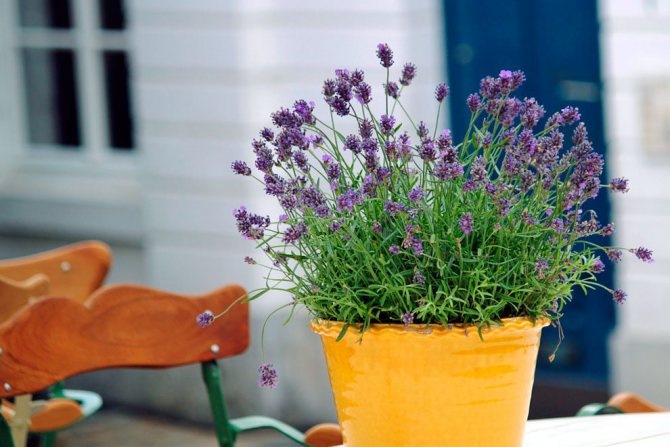

Potted lavender
This plant has 47 species and several hybrid forms, differing in bush height, bud shade and resistance. Some types are considered suitable exclusively for open ground. Others do quite well at home.
Potted Varieties
The most common varieties for indoor growing include:
- Narrow-leaved lavender (English). This perennial evergreen dwarf shrub is considered the most unpretentious and frost-resistant species cultivated in Russia. The height of this plant reaches a maximum of 30 cm. The inflorescences are on long stems, which are covered with narrow, elongated leaves of a gray-green hue.The flowers are blue with shades of lilac and purple. The flowering period is July-August.
- Lavender broadleaf (French). This species is characterized by the presence of wide leaves and thermophilicity, is the ancestor of decorative varieties. Caring for him is necessary exactly the same as for other relatives. This lavender has beautiful flowers in various shades. The plant lacks the pronounced smell that the English variety has. This species blooms from April or May to July. But at the end of summer, flowering can occur again. The height does not exceed 60 cm. The most beautiful representative of the species is lavender with butterfly-shaped flowers.
- Lavender toothed. The plant got this name because of the cut leaves of a silver hue. Large fragrant flowers appear in the middle of the summer season. This plant belongs to the thermophilic species. Designed for indoor cultivation.
On a note! Which variety to choose for himself, everyone decides for himself. In leaving, they are about the same.
The origin of the plant
Lavender has been known since antiquity. She is native to the Mediterranean, Canary Islands and India. In the distant past, dried lavender flowers were used for water treatments. The ancient Romans added her bath to the water for washing hands before eating, with the help of it they washed things. Because of this, the name of the plant from Latin lavare is translated as "wash".
Lavender has been used as a cure for infectious diseases. When there were epidemics, the Romans made lavender fires in front of their homes. Over time, lavender has become known around the world. Essential oils were made from it, lavender became a symbol of love and beauty, it was grown in gardens, used for cooking.
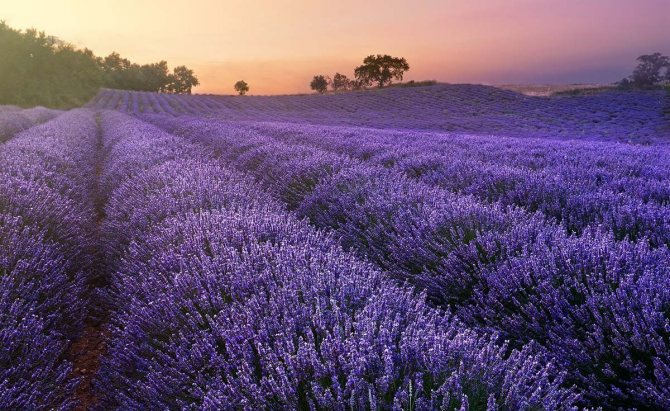

Lavender field
Growing lavender
Remember the popular lavender song? A mountain flower means it does not like wet soils with stagnant waters. The roots of the plant grow very widely, which allows it to extract moisture on its own. The plant loves well-drained soil and sun.
Pick-up location
It is very important for this plant to choose the right place. Open, sunny areas on the hills are exactly what lavender needs. In the shade, of course, it can also grow, only the flowering will not be so abundant and lush.
In addition, it must be borne in mind that the roots of the plant react negatively to waterlogging. It is unacceptable for her to plant in places with stagnant water and swampy areas. If you do not have a suitable planting site, do not be too lazy to make a mound and plant lavender there.
Lavender also has requirements for the composition of the soil, they may not be followed, but then, again, you will lose the privilege of enjoying the full splendor of flowering.
Soils should be chosen not acidified or deoxidized in advance with lime or dolomite flour. As a fertilizer, the plant loves making compost, which will make the soil fertile and loose.
Landing features
The plant is most often planted along curbs or paths. To make the bushes look more magnificent, the distance between them should be equal to the height of the variety that you are going to plant. It should also be taken into account that adult lavender plants do not tolerate transplanting very well, so dig up and transfer them with a large clod of earth. If it is not possible to dig out already mature bushes, you can choose an alternative planting method.
Breeding methods for lavender
It is very simple and quick to propagate lavender by cuttings. It is enough in the spring to cut cuttings about 10 cm long from lignified shoots and plant them in a loose and moist soil in a greenhouse. Water and ventilate them constantly. In the fall, cuttings with roots can already be planted in permanent places.
Sowing lavender seeds
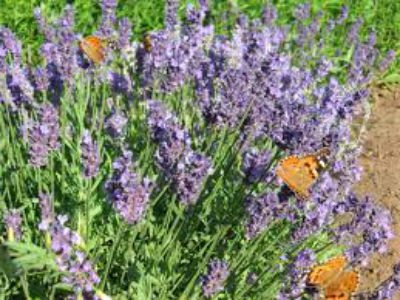

When properly stored, lavender seeds are capable of germinating for a very long time. Choose the time as it is more convenient for you to sow them. If you do this in the spring, in May, then place the seeds in wet sand in advance, pack them in a plastic bag and put them in the refrigerator for two months. You need to store at a temperature of + 2-4 degrees. You can dig seeds in a greenhouse in early spring, covering them with snow.
In autumn, in October, seeds are immediately sown in open ground, compacting the soil and watering well. Again, this is more suitable for gardeners of the Moscow region, where the climate is milder than in the middle lane.
Lavender care
Water the lavender as little as possible. Check when the soil under the bush is completely dry. If you notice that the shoots have begun to turn yellow, this is a signal that the soil is overly moistened and root rotting begins.
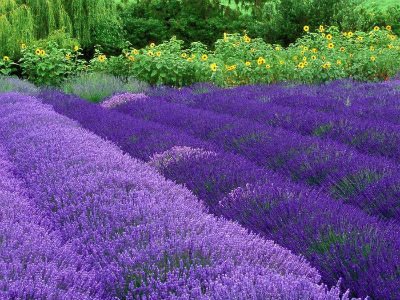

Perhaps this is the most important thing in lavender care, because its roots do not tolerate soil compaction, they need to breathe, so the plants grow and develop better. you need to loosen constantly, especially after each watering and rain.
To make it easier for yourself to free up time, you can mulch the soil around the bushes with humus or peat. It will also be a fertilizer.
Fertilizing and feeding lavender
In general, the plant does not need much feeding, especially if the soil is fertile. Nevertheless, to prolong the abundant flowering and ensure the growth of the plant, apply top dressing.
In the spring, nitrogen-containing fertilizers are applied once a month. They are necessary for building up green mass. But they are introduced only during the period of active growth, then we cancel them and switch to complex mineral fertilizers. They are used throughout the entire flowering period.
If you use compost or rotted humus as mulch, then you can do without additional fertilizing, the plants will take all the necessary substances from the soil.
Pruning lavender
If you notice a stop in the growth of a lavender bush, then it must be transplanted to a new place.
In general, pruning lavender bushes is not necessary unless you want round, fluffy bushes. They are cut in two stages:
You only need to trim by two centimeters, no more. When carrying out autumn pruning, do not get carried away, if you cut the bush too short, it may die.
Diseases and pests
Probably due to the high content of essential oils, the plant is not very susceptible to attacks by pests, and diseases are rare, especially with good care.
Of the diseases, the most common gray rot is due to improper watering. The disease cannot be treated, it is extremely important to notice it in time and remove diseased plants. They are taken out of the garden and burned.
Of the pests, you can find the rainbow beetle. But it is found in such small quantities that it is easy to pick it up by hand.
Preparing for winter
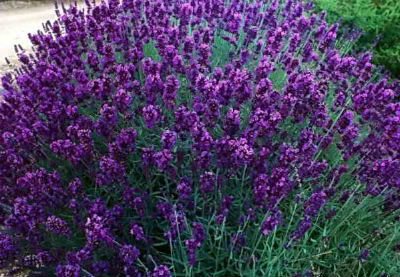

Lavender can easily withstand freezing temperatures down to -25 degrees. But still, in the middle lane, it is better to make shelters for it.
Do not cover the lavender bushes with fallen leaves for the winter, the plant will begin to flirt and may die.
The best shelter for shrubs, branches of conifers.The foil allows air to pass through well, circulating inside the shelter, and retains snow well.
In places with a mild climate, lavender is usually not covered with anything; it winters well without freezing.
Combination with other plants
Lavender can often be found along hedges, curbs, paths. It is planted in a composition with roses, they have a good aroma. Blue lavender flowers contrast well with orange or red flowers.
You can grow lavender next to hydrangea. It will look elegantly on an alpine slide among spicy herbs. Combines with sage and gypsophila.
Small varieties of lavender will look good in a planter on the terrace. Or you can experiment and plant a large piece of land with shrubs, you get an incredibly fragrant carpet of purple-blue flowers.
Application of lavender
The plant can be used to flavor tea, cold drinks, add to fish and meat soups, vegetable dishes. Lavender goes especially well with lamb.
Thanks to its essential oils, the plant has become widespread in medicine. It helps well with insomnia, nervous excitement and fatigue.
A fragrant lavender dwarf shrub, planting and caring for which is not very difficult, will adorn any garden. And its essential oils can be used in homemade soap making.
Lavender - Mediterranean aristocrat in a pot format
Lavender is one of the plants that needs no introduction. A true blooming symbol of the Mediterranean, it is still associated with garden design, but is increasingly seen in the interiors of coffee shops, restaurants and cozy shops.
Lavender is loved very much even by those who do not have a garden, and they have learned to grow it in a new interior format. It is difficult to call indoor lavenders something outlandish. They are actively planted in tubs, pots and flower girls in the homeland of the plant and are used in urban landscaping. So the change of status from gardening to indoor gardening was more of a matter of time.
Room lavender (Lavandula) - all the same herbaceous perennials, dwarf shrubs and shrubs from the family Lamiaceae (Lamiaceae) with a high content of essential oils in all aerial parts. Their strong, gradually woody underneath shoots and opposite, lanceolate, pubescent leaves in different species and varieties differ in the intensity of low tide in dense, constantly growing bushes. They are recognized as easily as their flowering.
Lavender greens range in color from cold and almost emerald green to silvery gray and warm herbaceous hues. According to it, you can choose varieties in the same way as in the shades of inflorescences. The bushes in the rooms, depending on the species, can either grow to almost half a meter in height or remain compact, but they are always very dense and elegant.
Lavender usually blooms in the summer, although indoor lavender can be found on sale as early as spring.
Lavender produces bisexual, medium-sized tubular flowers that are collected in small whorls in complex spikelets of inflorescences at the tops of leafless shoots. The large enough spacing between the whorls makes the lavender spikelets very elegant.
The color scheme of lavender includes all shades of the blue-violet spectrum - from the most delicate and pastel whites, light lilac-pinks to dark saturated tones.
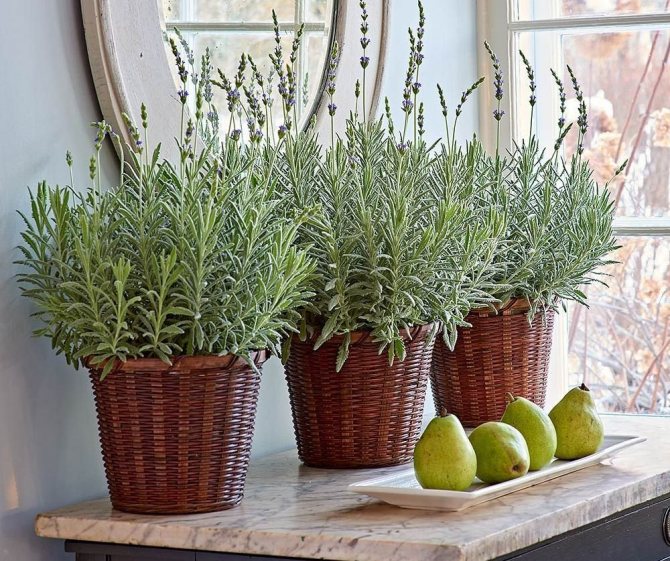

The lavender color scheme includes all shades of the blue-violet spectrum.
Popular varieties
There are about 37 types of lavender in the world. Only two of them are used as cultural ones: French and English.
French
French lavender has wide leaves and lush buds with a distinct aroma. Flowers have a wide range of shades: white, pink, lilac, burgundy. French lavender blooms twice: in April or early May and mid-August.
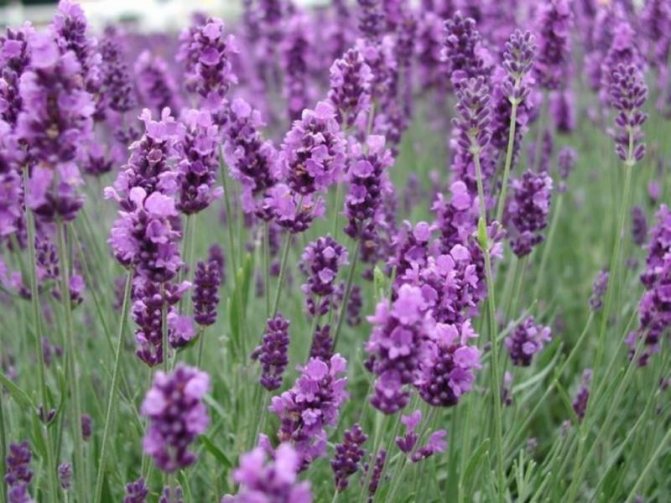

French lavender is a wonderful honey plant - its nectar attracts bees
English
English Lavender (Narrow-leaved, or Medicinal, or Angustifolia) is a plant with silvery-green leaves and small bluish-lilac flowers. It gives many shoots with a whitish edge, which is why it acquires a bluish tint. The bushes bloom in July and bloom for about two months.
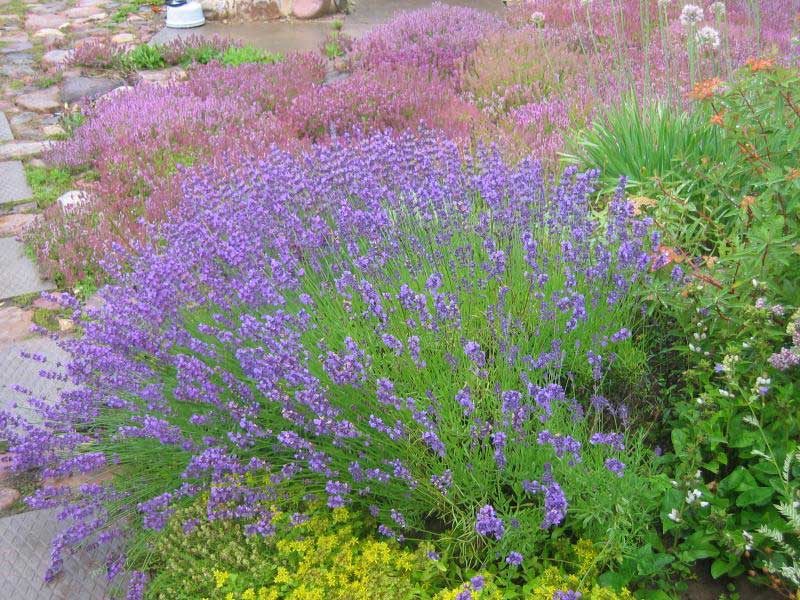

The plant is of great industrial value - it is used to obtain essential oils and medicines
Dutch
Hybrid Dutch lavender, derived from English, is very popular with gardeners. This is a plant with large peduncles, reaching two meters in height. It blooms in July. Dutch lavender is less hardy than English lavender.
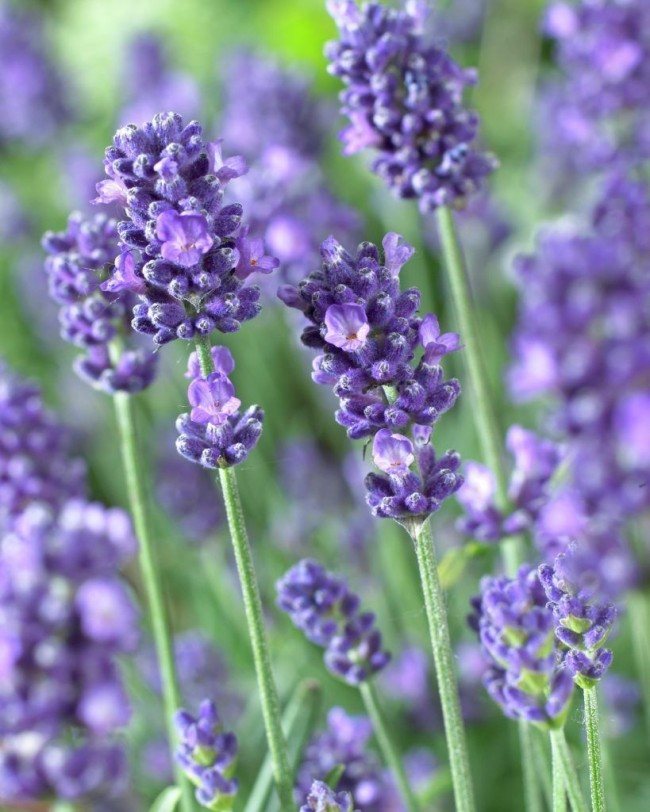

Most popular hybrid lavender varieties: Alba, Arabian Knight, Sawyers, Grosso, Richard Gray
Jagged lavender with carved leaves and large fragrant flowers is widely known. It is used as a houseplant.
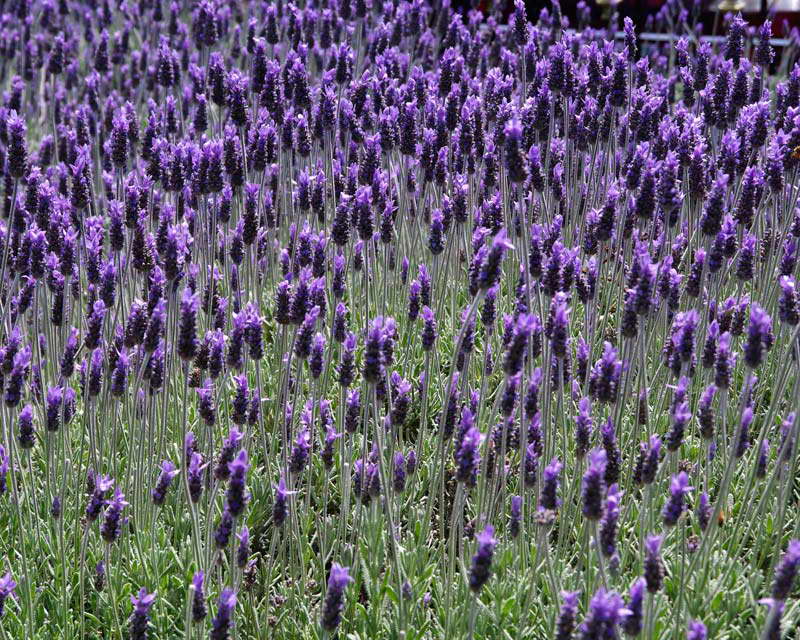

Outdoors, this thermophilic shrub grows only in the Crimea and the Mediterranean.
Growing features
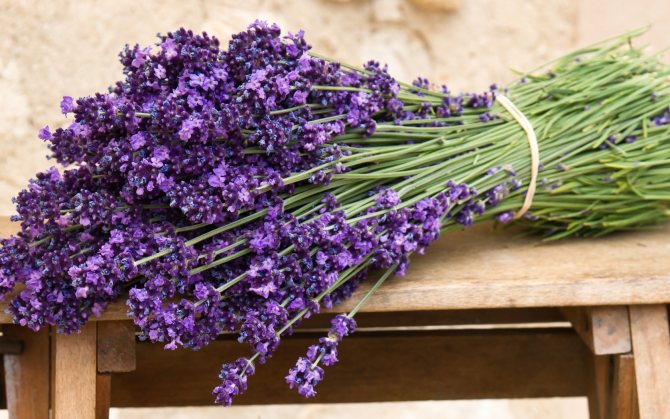

Lavender is rarely more, and is almost never attacked by pests. However, gardeners can still face the following problems:
- Gray rot... The leaves and shoots of the shrub are covered with a silvery-gray bloom. This is a consequence of waterlogging of the soil and stagnation of moisture in the air. The affected parts of the plant will have to be cut and burned. To maintain the health of the entire bush, it will have to be treated with a 0.2% Fundazole solution.
- Rainbow beetle... If you spot the colorful bugs on the lavender, it will be easy to pick them up with your hands. In extreme cases, the shrub can be treated with an insecticide (Aktara, Aktellik, Inta-vir or other means).
- Pennitsa... It does not cause damage and does not feed on plant sap. But she uses it in order to lay offspring there, which is covered with a layer of foam. They look like foamed saliva. You can remove this "beauty" if you pour lavender from a hose with water under medium pressure.
Lavender is a luxurious shrub that requires special care due to its habit of growing in mild climates with mild winters. But, having mastered the skills of pruning and the features of sheltering the plant for the winter, you can turn your garden into a mini-Provence. And you will enjoy not only the amazing aroma, but also warm and sweet tea made from delicate lavender twigs and inflorescences.
Sowing with seeds
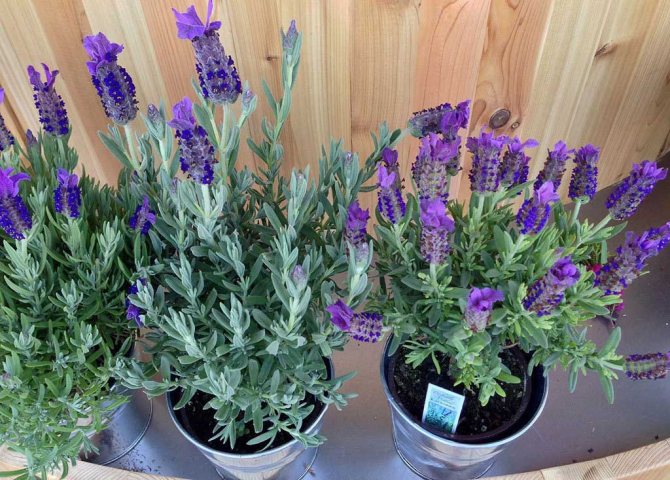

What do you need to know about this method? And can lavender be grown from seeds? Planting and caring in the open field requires certain knowledge and skills. A lot determines the quality of the planting material. When stored properly, lavender seeds are capable of germinating for a long time. You should also consider when it will be more convenient for you to sow the seeds. If you want to do this in the spring, then they should be placed in wet sand in advance and placed in the refrigerator for a couple of months. Lavender seeds should be stored at a temperature of 2-4 degrees Celsius. In early spring, seeds can be dug in a greenhouse, covered with a layer of snow.
If you choose autumn for planting, then the seeds can be planted immediately in open ground. After that, the soil should be well compacted and watered. For gardeners of the Moscow region, this method is better suited, since the climate here is milder.
How to choose planting material
Lavender can be grown by sowing seeds, or you can buy ready-made seedlings. In summer, you can take a cutting from an adult plant and root it. Adult bushes do not tolerate transplanting very well, so grown seedlings are rarely sold.
Seeds retain their germination well for several years if stored in a dry and dark place. Therefore, when buying seeds, you need to carefully inspect the packaging, it should not be damaged or with traces of getting wet.
When purchasing seedlings, you should inspect the plant for damage and disease.To be sure that the purchased plant matches the declared variety, you need to take planting material only in nurseries and large specialized garden centers.
Basic information
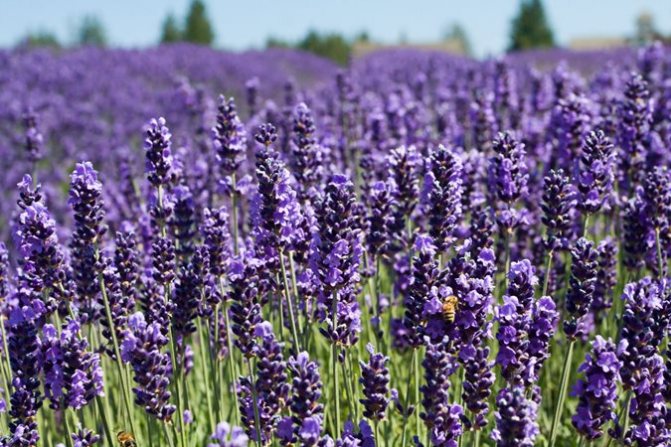

Lavender is a dwarf shrub from the Lamiaceae family. Its closest relatives are rosemary, mint and thyme. In nature, lavender is found near the Mediterranean Sea. In total, there are approximately 28 varieties of this plant. Lavender is actively used in the perfumery industry to create perfumes, eau de toilette and scented soaps.
Frequent growing problems
When cultivating lavender, there is a risk of various problems. They should be taken into account for the full development of culture.
Long root
The plant develops a long central root. Therefore, he needs to provide a sufficient amount of space. Sufficiently deep pots are suitable for growing lavender.
Lack of light
Quite often, lavender suffers from a lack of lighting. In such a situation, the culture needs artificial lighting. For this, special lamps are used. The minimum daylight hours should be 10 hours.
Outdoor ventilation
Culture needs fresh air. In a stuffy room, its growth slows down. Therefore, the room in which the lavender is located should be constantly ventilated. In summer, culture is taken out on the street or on the balcony.
Window sill requirements in winter
In winter, the plant needs a sufficient amount of light. Therefore, it should be placed on the southern windowsill.


Incorrect feeding
When growing a crop at home, you should definitely apply fertilizer. This is especially important within 2 months after germination.
Annual transplant
Transplanting the culture is undesirable. She can hardly bear this manipulation. Therefore, it is recommended to move lavender to a new place only if necessary.
Gray rot
With the development of pathology, foliage and shoots are covered with a gray bloom. The disease is caused by increased soil moisture. During its development, the damaged fragments are recommended to be cut and burned. The rest of the bush should be treated with Fundazol with a concentration of 0.2%.
Top dressing and fertilization
Long-term lush flowering requires a large amount of nutrients, therefore, during this period, the plant should be supported by the introduction of complex mineral fertilizers. Organic fertilizers, which contain a significant concentration of nitrogen, are allowed to be used only at the beginning of the growing season, during the growth of new shoots. Later, organic matter should be excluded if there is a desire to admire the flowering.
Advice! Organic fertilizers will completely replace soil mulching with compost.
Preparing for winter
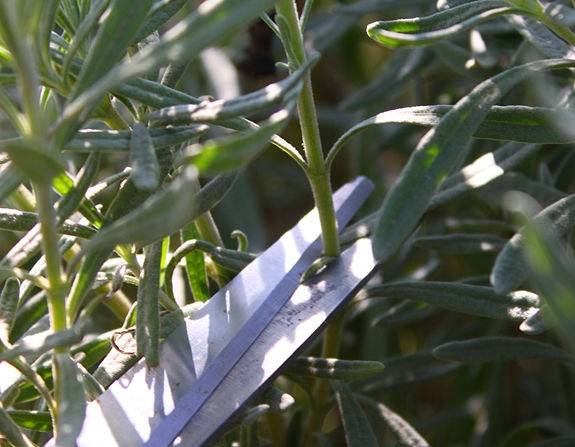

Even though homemade lavender grows into an evergreen ornamental plant, it still preparation for wintering is necessary... After flowering, dry stems should be removed and the bush should be slightly trimmed (several nodes above the beginning of leaf growth).
Winter is the time for the plant to rest, therefore, it needs to be watered less - maximum once a week... Keep the pot in a cool place away from heating appliances.
If you notice that the overgrown leaves begin to drop and wither - do not be alarmed. This can be in poor lighting, and not from a lack of moisture. The plant accumulates water only in thick grayish leaves, so try to resolve the issue with lighting as soon as possible.
What types of philodendron are suitable for indoor keeping, our article will tell.
How easy it is to care for indoor violets, read here.
Sometimes lavender blooms in winter, but this not good for her health... If lavender has bloomed, you need to remove the growths before taking it out to the balcony in spring. Spring flower can transplant into another pot.
Lavender - care after flowering
Lavender in winter
If in your area the temperature in winter can drop below 25 ºC, you need to reliably protect the area with lavender from frost, but do not use fallen leaves as insulation, as lavender can rot under it in winter. It is best to cover the lavender bushes with spruce branches after the autumn pruning.
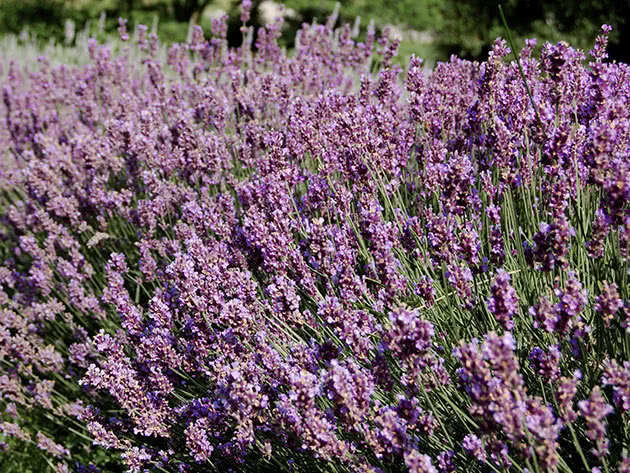

Photo: Blooming lavender field
In areas with not so cold winters, narrow-leaved lavender is not covered.
Planting methods
Lavender is grown on the site in three ways: by seeds, cuttings and layering. It reproduces easily vegetatively and gives a lot of young growth for reproduction. But if you want to plant a new variety, then you can try growing a plant from seeds - it's not that difficult.
Sowing seeds
Growing lavender from seeds has its advantages: their price is low - much lower than that of seedlings or cuttings. With proper seed treatment, plants grown from them acquire good immunity.
Seeds must be stratified before planting. This procedure improves their germination and increases the resistance of future seedlings to diseases and cold weather. Stratification is done in two ways:
- Natural. Seeds are planted in the fall in the ground. During the winter they will be exposed to low temperatures, their germination and adaptability will increase. This method is not suitable for the middle zone - the seeds may die from frost. If the climate is quite warm, then sowing is done in October. The seeds are planted at a depth of 4 mm and compacted. If the land is dry, then irrigate. In winter, the planting site is covered with snow.
- Artificial. The seeds are placed in a container with wet sand and mixed, put it in the lower drawer of the refrigerator for one and a half to two months. Seeds are planted on seedlings in the second half of February - early March, so stratification is carried out from late December - early January.
Light soil must be prepared for seedlings. Three parts of garden or forest soil are mixed with one part of sand. If the soil is not fertile enough, humus is added to it. You can also buy ready-made seedling soil from a flower shop. Landing is done as follows:
- Seeds are rarely planted in a container, since the roots of lavender immediately begin to grow;
- They are not buried - they are only sprinkled on top with a thin layer of sifted earth;
- Moisten the soil;
- The container with seeds is covered with glass or tightened with plastic wrap, then placed in a warm, bright place.
Seeds germinate for a long time. In two weeks, single shoots will appear, and mass shoots will appear in a month. After their appearance, the shelter is removed from the seedlings. When two true leaves appear at the seedlings, they are dived into separate pots or cups. In order for the seedlings to grow strong and healthy, they need proper care:
- The containers must be drained to prevent water stagnation. For this, there must be holes in the bottoms. Additionally, a small layer of pebbles is placed there.
- You need to water the seedlings at the root, for which you can use a medical syringe.
- If the soil is compacted, then it is loosened with a toothpick.
- For proper development, plants need ten hours of daylight. If there is not enough light, they make a backlight.
- If it is warm enough in April, then the seedling boxes can be placed in the greenhouse.
Seedlings are transplanted into open ground 60 days after germination. In the middle lane, planting is carried out at the end of June, when the soil warms up enough.
Lavender seeds can also be planted directly into the soil. Planting is carried out in May, when the threat of frost has passed.
Plant propagation
This is the fastest and most effective way to propagate lavender. Cuttings are carried out in the same way as in other plant species:


Cuttings from last year's shoots must be pre-soaked before planting in a root formation stimulator
- An annual shoot is cut with a sharp knife.
- Cut into cuttings 8-10 cm long.
- They are planted in light soil, rooting 2-3 cm.
- Cover with a small greenhouse on top.
The soil must be constantly moist. After three to six weeks, the cuttings will develop roots, after which they can be transplanted to a permanent place.
Reproduction by layering
It happens quickly and easily. To obtain layering at the beginning of summer, the lower shoot is bent to the ground and placed in a previously prepared groove. To keep it in place, it is fixed with wire and sprinkled with earth. The shoot is regularly watered. After two months, he will develop roots, after which he is separated from the bush and transplanted to a permanent place.
Landing in the ground
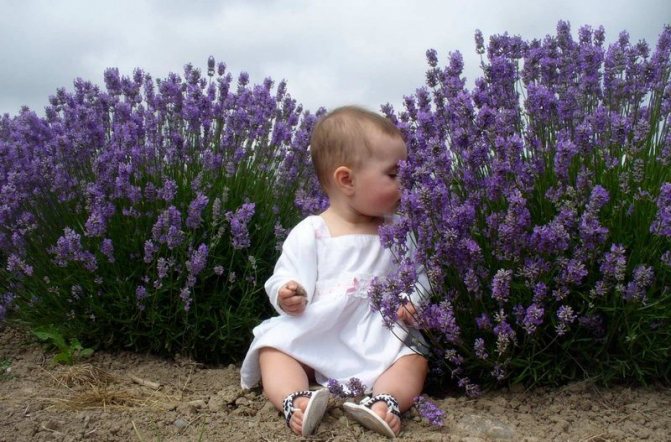

For children, the smell of lavender helps with increased excitability and sleep problems
In order for the bushes to grow lush, they need to be planted rarely. 50-60 cm are left between ordinary seedlings, about 100 cm between tall ones. Lavender prefers light, air-permeable soils. The earth must have a slight alkaline reaction, for which you can add some ash or lime to it.
Before planting, the earth is dug up and the roots of the plants are removed. The seedling is placed in a prepared hole, the roots are straightened and covered with earth so that the root collar is deepened by 4–6 cm. The plant is watered abundantly. Lavender blooms in its second year after planting.
The plant has some features to consider when choosing a planting site:
- This is a light-loving shrub that is planted in sunny places. Young plants are shaded so that they are not burnt by the sun.
- Lavender loves moisture. In dry summers, it needs to be watered frequently. It is better not to plant the plant where it is difficult to organize watering.
- Lavender is a good honey plant that attracts bees. It should not be planted near places where children play. Also, don't plant lavender under your bedroom windows. The strong odor and essential oils it releases can cause headaches, allergies, and disrupt sleep.
- The plant does not like stagnant moisture, so there must be good drainage at the planting site. It can be organized from broken bricks.
Care
Growing lavender in a pot is easier than growing garden varieties. The flower does not tolerate any sudden changes in external conditions, so all manipulations should be carried out carefully, monitor the condition of the leaves and shoots.
Watering
During the entire growing season from mid-May to October, lavender is watered regularly up to 3 times a week, the soil should not be allowed to dry out. In winter, procedures are reduced to a minimum, while maintaining a moderate soil moisture. Water only the leaves so that the water flows into the root of the plant. Spraying is recommended on hot days. For lavender, soft water with a minimum salt content is suitable.
Top dressing
Potted lavender needs regular feeding. From mid-spring, it is advisable to apply nitrogen compounds, after flowering - potassium-phosphorus fertilizers. It is best to choose a liquid flowering plant mixture for root feeding. The procedure is carried out once every 2 weeks after the next watering. In winter, fertilization is excluded.
Loosening, mulching
The plant can only grow in light and aerated soil. After each watering, you should slightly loosen the soil with a wooden or plastic stick to a depth of 5 cm. Work should be done very carefully so as not to damage the weak root system of lavender. Mulching at home is carried out only for decorative purposes; colored stones, perlite or fine river sand are used as material.
Pinching, pinching, pruning
Decorative shaping should be carried out once a year to maintain the attractive appearance of the bush. All overgrown and too long shoots are cut off. It is desirable to maintain the shape of a small shrub.To prevent diseases and enhance flowering, it is useful to pinch dried and affected parts of the plant, as well as faded buds.
Transfer
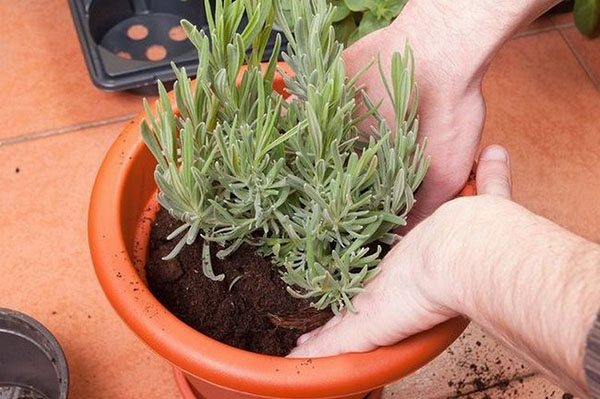

The procedure is recommended to be carried out annually before the beginning of the active growing season in spring. This is necessary for the rejuvenation of the plant, increasing the growth rate. You can determine the need for transplanting by the appearance of the bush - many new shoots have appeared near the edge of the pot, lavender has slowed down growth and development. For transplanting, you should pick up a more spacious container, and then carefully transfer the plant there along with a lump of earth, supplement the voids with fresh substrate. After that, the flower should be placed in a well-lit and warm place.
Choice of place and conditions of detention
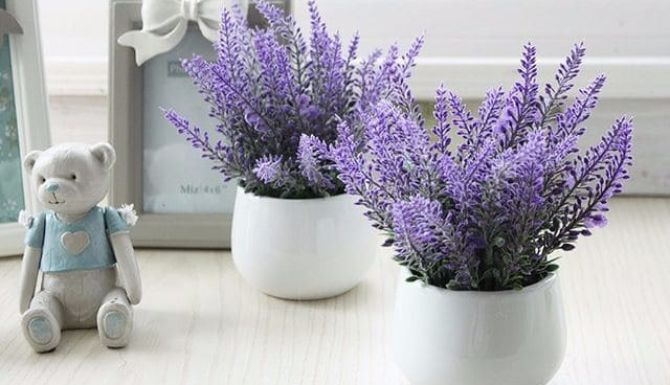

Ornamental lavender is considered a capricious plant. To avoid problems with flowering and growth of the bush, you should correctly approach the choice of a place for growing. The flower is sensitive to any changes in external conditions, which is important to take into account even at the planting stage.
Lighting and location
Lavender is a light-loving crop, even a slight darkening can lead to a decrease in the growth rate, wilting of shoots. The pot with the plant should be placed in the center of the window sill on the south side of the apartment; in summer, it is best to take the flower out to the balcony, loggia or adjacent territory. The recommended daylight hours are 10 hours. In winter, with insufficient lighting, it is advisable to carry out additional illumination with a phytolamp.
Temperature
Room temperature is comfortable for lavender development. The plant has a weak frost resistance, it can die at temperatures from -15 ° C. If you keep a flower pot on the balcony, with the first return frosts, you need to bring it into the house. During the entire growing season, it is recommended to maintain warmth in the range of 15-24 ° C; during the transition to the dormant period, the temperature can be lowered by 3-5 degrees.
Air and humidity
The plant is insensitive to air humidity, it can grow in the range from 60 to 80%. Regular ventilation is desirable to support growth and development. Lavender reacts well to fresh air, but exposure to drafts can be detrimental to it. During the heating season, it is recommended to spray the leaves once a week.
Soil and pot
For planting ornamental lavender, it is recommended to choose a spacious pot to accommodate a strong root system. The optimum diameter is 25-30 cm. The total volume should be at least 3 liters. Low-growing lavender varieties can be planted in a common rectangular container. There should be drain holes at the bottom. Experienced gardeners recommend choosing products from light-colored ceramics.
The soil should be fertile and loose. It is advisable to use ready-made mixtures for ornamental flowering crops. If you prepare the soil yourself, then you should mix turf, river sand and humus in a 2: 1: 1 ratio. Before planting, the substrate must be disinfected with a 1% solution of potassium permanganate.
Top dressing
What else should be remembered for those who have lavender growing on the site? Planting and caring for this plant in the Moscow region does not provide for regular feeding. This is especially true when lavender is grown in fertile soil. If you want to prolong flowering, then you can use special fertilizers.
In the spring, nitrogen-containing mixtures can be added to the soil. They are required to build up green mass. They should be introduced only during the period of active growth. After that, you can switch to complex mineral fertilizing. They are used throughout the entire flowering period. If humus and compost are introduced into the soil, you can do without top dressing altogether. The plant will take all the nutrients necessary for growth from the soil.
Application in landscape design
There are many ideas for decorating decorative flower beds in landscape design. Lavender will harmoniously complement the landscape around the house with its colors, exquisite flowering and incredible beauty.The bushes in the rock garden and mixborder look gorgeous. They are given a place in the center of the flower bed, where they are clearly visible from all sides.
Tall varieties can be planted in small groups, for example, on alpine hills. At the same time, just do not violate the design of the mountain landscape and choose the right neighbors.
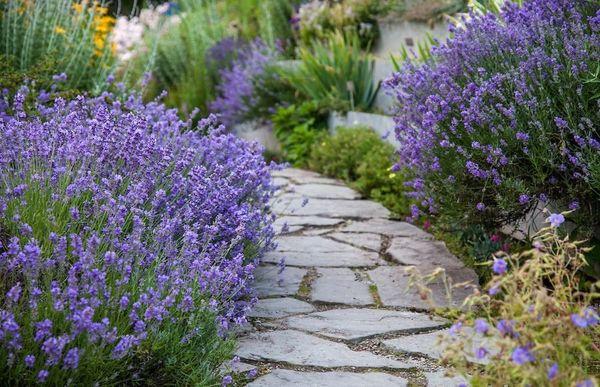

Lavender looks gracefully as a border that adorns the alley in the garden. Flower framing allows you to divide the garden into zones. Also, the plant will look good next to elegant standard roses.
A carpet of flowers can become an original decoration of the garden. To do this, determine in advance the height of the shrubs and systematically cut them off at the same level.
Growing lavender will not be difficult, even for novice florists. And with proper planting and proper care, an evergreen perennial will decorate flower beds in the garden with its flowering for a long time.
Propagation of lavender by cuttings
To do this, take young lignified shoots of a healthy annual bush. The inflorescence is cut from the cutting and the lower leaves are removed to a height of 3-4 cm. Ideally, stems that have not yet bloomed are used. Dry sand, soil, clay shards and medium pots are prepared for grafting. The shards are placed on the bottom of the pot, a layer of already moistened sand is organized on top. Then earth is poured onto the drainage layer and everything is rammed. Another layer of wet sand is made on top - 1.5 cm thick. The soil itself is prepared from several components. Sand, leaf and turf are used in equal proportions.
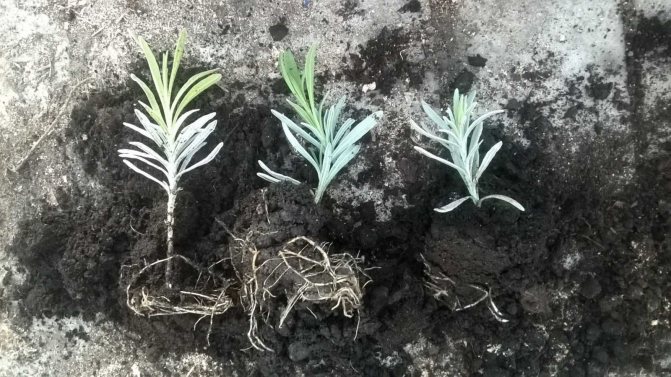

Cutting is the most convenient way to obtain large quantities of lavender seedlings.
The prepared stalk is treated with growth stimulants and buried in the ground with the cleaned side. Rooting is improved by "massage" the lower part of the shoot. Sometimes they organize a mini-greenhouse: lavender is carefully covered with plastic wrap.
Possible problems
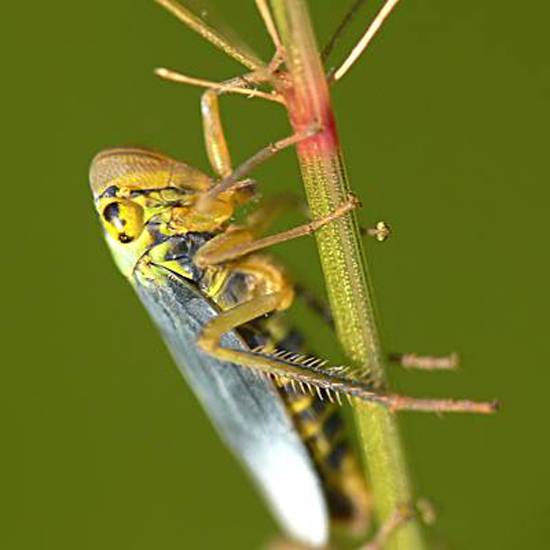

Lavender is rarely affected by pests, especially at home. Moreover, with its help you can fight with many bugs.
Her main enemy – overflow... Since lavender is quite drought tolerant, it is better to underfill rather than pour it over. Signs of overflow are decay of roots and yellowing of shoots, leaves.
Since the soil for lavender requires loose soil, it very fond of weeds... At home, such a phenomenon is rare, but it also happens sometimes. It is very important to prevent weeds from oppressing the plant.
It is also worth protecting the plant from leafhoppers and septoria... A suspension of copper oxychloride will help against septoria, and phosphamide against pests.
Wintering
After the autumn sanitary and formative pruning, the bushes must be treated with a 0.2% Fundazol solution. Then, when light, but persistent frosts come, they are covered with spruce branches. The advantage of this insulation is that the plant underneath it continues to breathe. And the ventilation of the air prevents the formation of rot. The scent of the resin scares away rodents, so the lavender will remain safe and sound. It hibernates better if you cover it with a large pile of snow in the winter.
Advice! With the onset of above-zero daytime temperatures in spring (about March), it will be necessary to remove all the snow from the shelter so that the bush under it does not vanish.
Propagation of lavender by layering
Propagation by air layers is used in the cold season of spring, that is, at maximum air humidity. To implement this method, you do not need to buy seeds or prepare cuttings. The principle is as follows: on an adult bush, choose the oldest branch (always alive), cut off the bud and lower the end of the branch into a small dug hole. Sprinkle the shoot with soil on top to fix it. The resulting hump is watered every two days. After 5-7 days after planting, it is fertilized. It so happens that the stem is springy. Then it is fixed with a stone or a hairpin, additionally covered with earth.
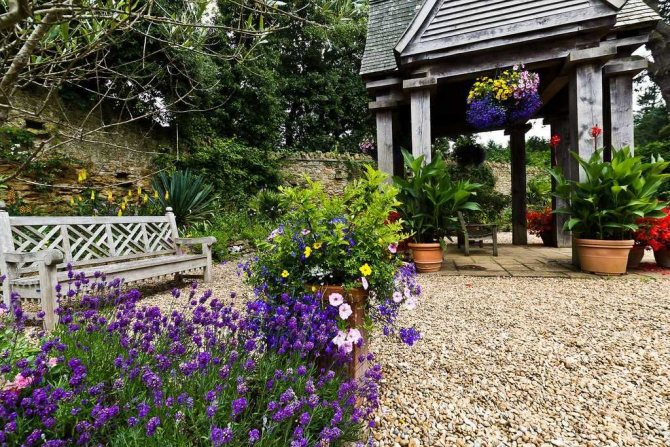

Using layering is the easiest way to propagate a shrub.
Propagation by air layers can be done naturally. If you look under the bush of an adult plant, then, most likely, several shoots will be found there. It is a kind of self-seeding lavender.
Can lavender be grown on the balcony?
Experienced florists say - quite.
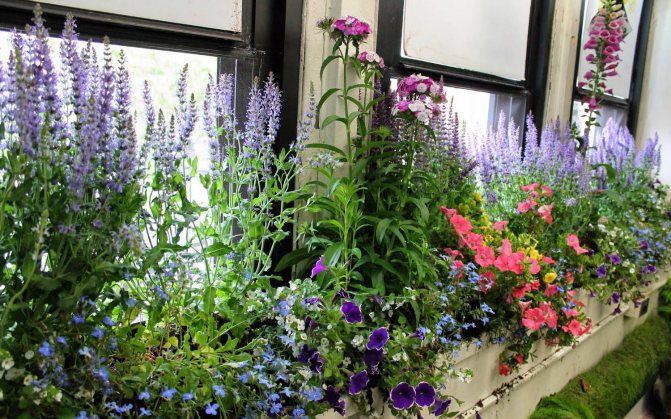

To do this, you should select narrow-leaved dwarf varieties of lavender with a small root system and plant them in stable high ceramic containers, placing them directly on the balcony floor or securely fixing them at its edge.
Fill the pots with sandy loam and water occasionally, drying well with an earthen lump.
Wintering should be taken care of additionally, covering it well if the balcony is not glazed.
Wintering lavender
Before wintering the plant in the field, a shelter should be organized. At the same time, according to experts, lavender tolerates frost well even at short-term temperatures of -25 ° C. If there are long periods in the region with the temperature around this mark or it generally drops below it, then a high-quality shelter will be needed. Do not forget that winters can be rainy. It is better not to give up the canopy. At the end of the transitional season, the bushes are pruned. Twigs of coniferous trees are placed in the garden as insulation. The leaves will not work, because this can cause rotting processes in the lavender bush.
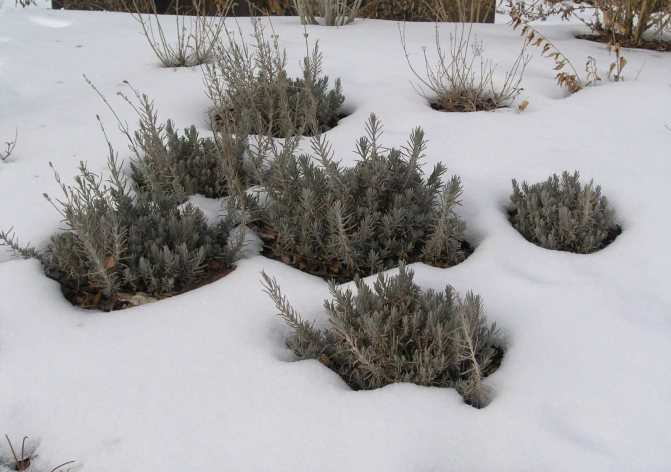

The narrow-leaved lavender variety is distinguished by good resistance to frost.
Thanks to compost mulch, it will be possible to avoid loosening, weeding, and top dressing. This makes maintenance easier. You only need to cut the plant so that it strengthens and then blooms profusely.
Photo gallery
Photo of different varieties of lavender
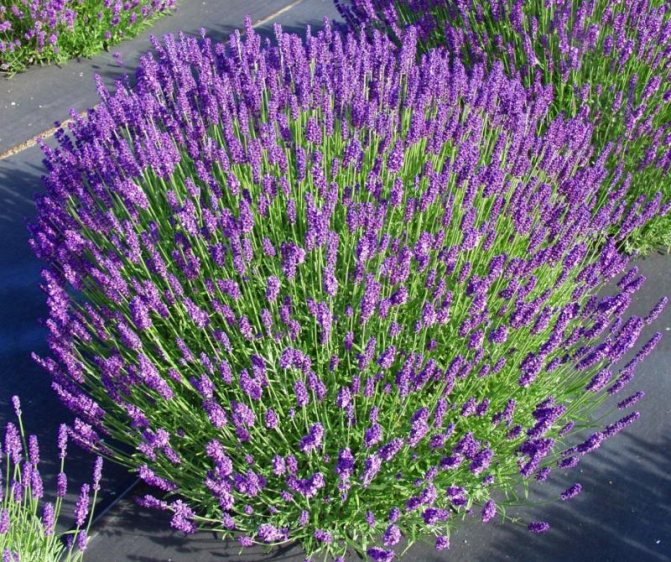

Lavender Heathcote
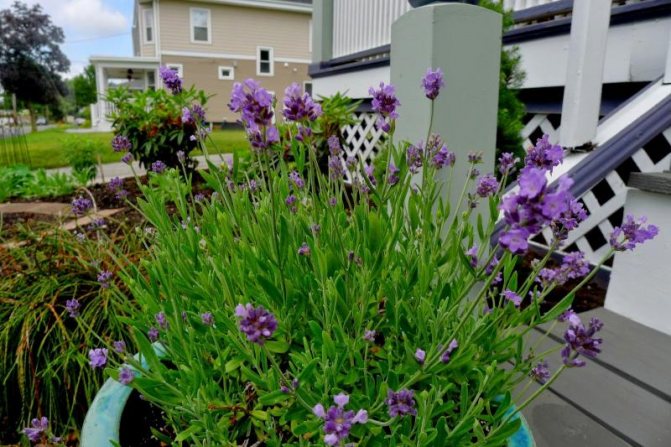

Lavender Sweet
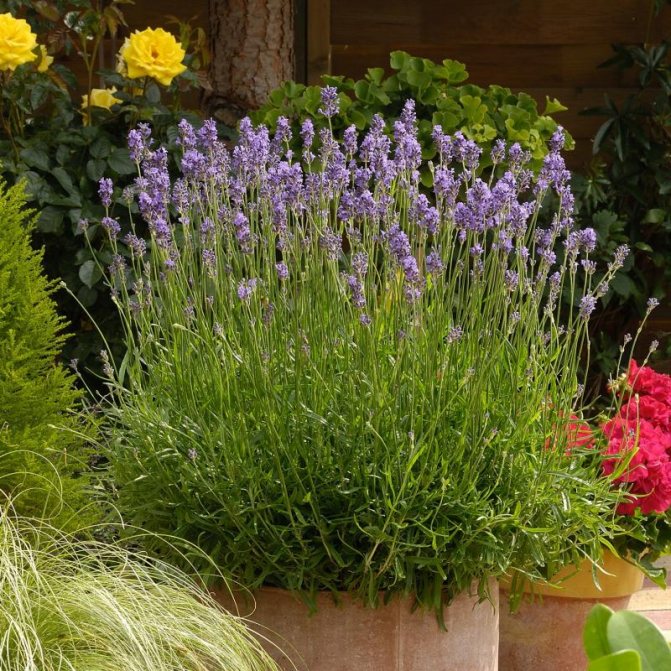

Lavender Sharon Roberts
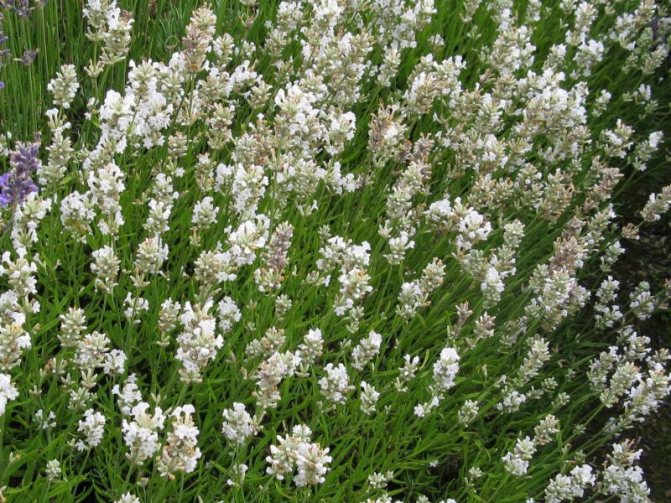

Lavender Snow Men
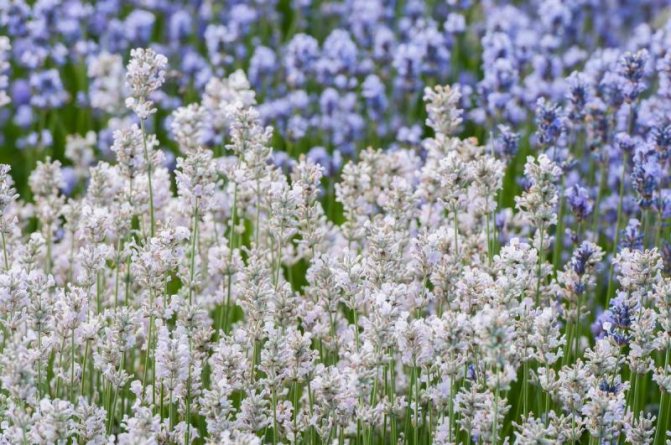

Lavender Nana Alba
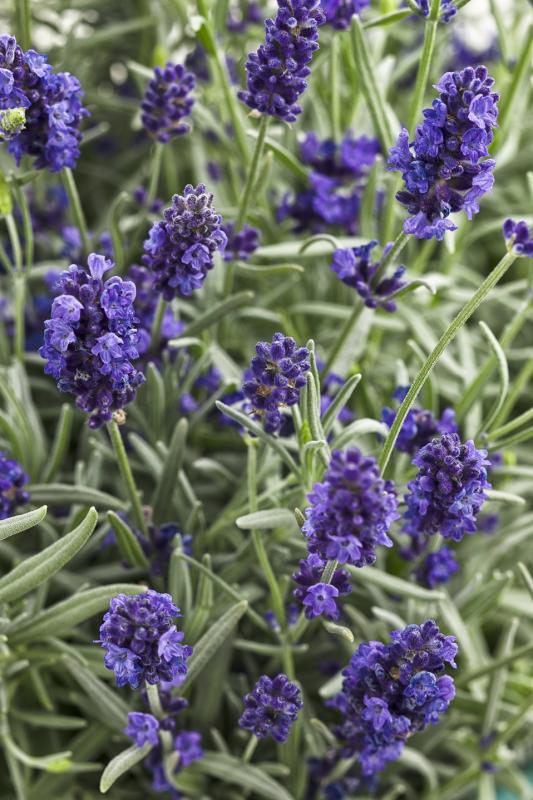

Lavender Manstead
How to plant lavender correctly
Before planting, the bush is placed in water for an hour or an hour and a half. Then the top is cut off for better tillering. Strongly protruding lower branches and roots are eliminated - this is a must. If a bed of boards is planned in the garden, then their width is selected up to 40 cm. Accordingly, it is equal to the height restriction. As for the depth of the pit for medium-sized lavender, they are guided by about 30 cm.The distance between the pits of neighboring bushes is selected at the level of 30 cm - for small ones, 120 cm - for high ones. The wells are filled with fertilizer, and a layer of pine bark or bone meal is sometimes added on top of it. All this is mixed with soil.
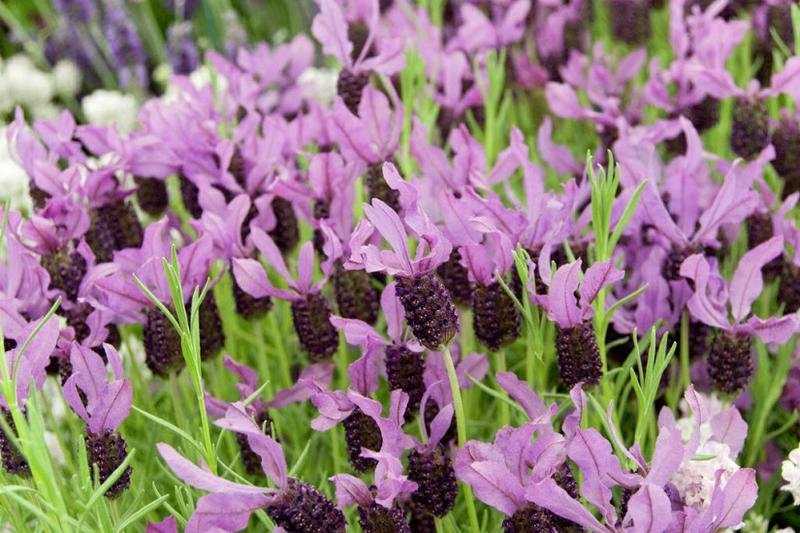

Since shrubs grow on the sides, it is not recommended to plant them too closely.
In case of problems with drainage, it does not hurt to add some pebbles. These measures will contribute to the normal onset of growth. Lavender is placed in a hole, pressed against the walls and bottom with emphasis. The roots should not come into close contact with the fertilizer. The layers above will help in this sense.
Bush formation
This procedure is optional. Even if you do not completely take part in the formation of the bush, it will still grow and bloom. If you want to have larger and fluffier bushes, you will need to resort to cutting. To do this, first wait for the flowering period to end and all the flowers to dry out. Before the cold period sets in, you need to cut each twig a couple of centimeters. Do not prune any more, or the entire bush may die over the winter.
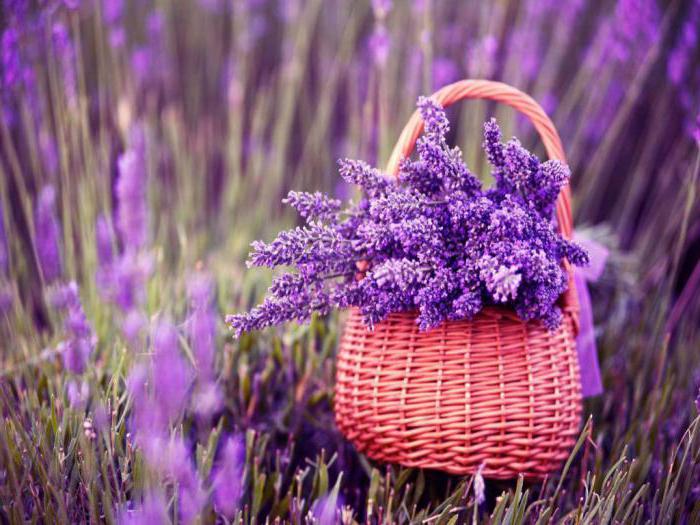

Breeding methods for lavender
To plant a plant, you will need:
- fertilizer;
- the soil;
- ripper or cultivator;
- shovel;
- rake;
- containers.
There are 4 main methods of reproduction: cuttings, sowing seeds, layering and dividing. The first 3 are considered the best options for various situations, and division is only a spare. Cuttings are a convenient method of obtaining seedlings for planting bushes in large quantities. The bottom line is to cut 8-10 cm shoots for intermediate rooting in a mixture of sand and peat.Reproduction by layering is natural and artificial. Even with the second option, the likelihood of injuring the bush is minimized. The daughter bush is dug up when the shoots are formed. Growing from seeds is not the easiest way.
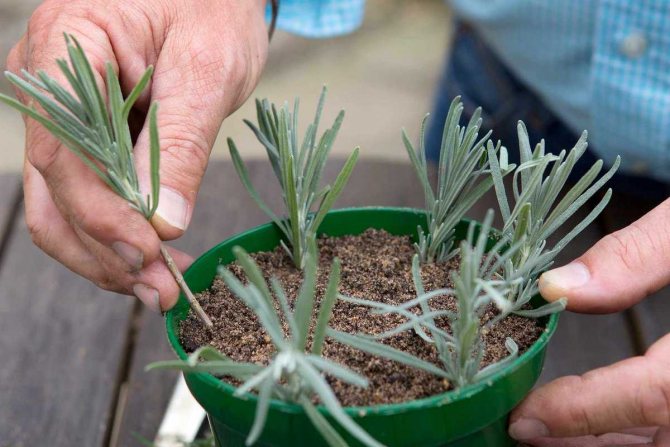

Most often, the plant is propagated vegetatively, but if you wish, you can grow shrubs from seeds.
The seedlings will not bloom soon, and you will need constant control over the temperature regime for the seeds. Reproduction by division is relevant if, for some reason, the other methods did not fit. The bush is prepared in the fall, and the procedure is performed only after a year.
Lavender flower: description
Lavender is a semi-shrub of the Lamb family (Lipocytes), an ornamental, perennial, evergreen plant. It grows wild in India, the Canary Islands, Saudi Arabia, Europe, Africa.
The trunk is small. The branches begin almost at the very ground. Flowers from pink to purple. Bloom up to 10 years. It grows up to 70-100 cm. A pleasant smell is emitted.
Lavender is a relative of aromatic herbs:
- motherwort;
- thyme;
- sage;
- mint;
- basil;
- rosemary;
- oregano.
Answers to readers' questions
Plant lifespan
The life span of a plant in culture can be 20-30 years, but bushes are often grown for no more than 10 years.
Why doesn't the flower bloom?
Flowering may be absent due to the small age of the plant if the lavender is grown from seed, or it may be caused by maintenance errors. Most often, flowers do not appear for two reasons:
- The landing site is too shady;
- The plant was overfed with nitrogen fertilizers.
Types of lavender for home cultivation
The birthplace of lavender consider the Mediterranean coast, which speaks of its heat-loving nature. To date known about 30 types, but the most popular of them are only three:
- English (narrow-leaved),
- Dutch (hybrid);
- French (broadleaf).
The latter is more suitable for growing at home.
This plant became famous for its useful properties - it is not only a decorative element, but also widely used in cooking, aromatherapy, perfumery and even medicine.
Broadleaf lavender is the ancestor of decorative varieties. The flowering period lasts from early May to August.
Most popular varieties broadleaf lavender:
- Regal Splendour;
- Tiara;
- Papillon.
Suitable varieties
The botanical genus Lavender includes about 50 species. The most common and suitable for growing in an apartment are:
- narrow-leaved, with elongated pubescent leaves and spikelets of inflorescences from pale blue to purple;
- serrated, with fleshy jagged leaves, like succulents;
- woolly - the leaves are whitish, covered with tomentose pubescence, the inflorescences are high;
- broadleaf - the most rich in aromatic oils;
- multi-cut - triple inflorescences, leaves - fern-like;
- petiolate - tall peduncles with purple flowers, the whole plant is fragrant;
- stekhad - pinkish-purple flowers on rounded inflorescences.
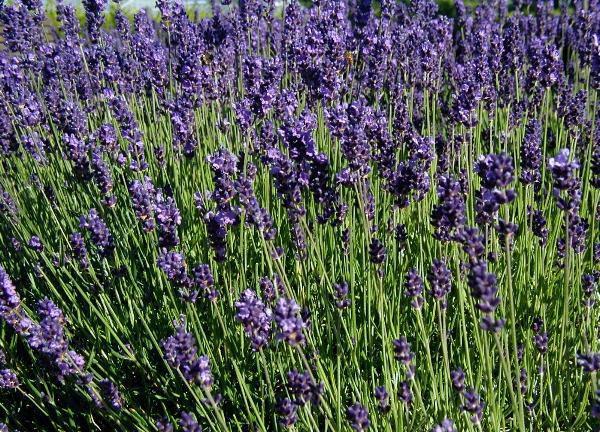

All these species belong to the Lamiaceae family, which are widespread in areas with a temperate and maritime climate.
Narrow-leaved lavender varieties
Seed producers offer domestic lavender varieties Izida, Sineva, Stepnaya and Yuzhanka for purchase with flowering periods from mid-June to early August. However, at home, plants can bloom earlier, and with good care, they can give flowering shoots throughout the year.
It is important to remember: in autumn and winter at home, flowering will not be plentiful, as with the arrival of spring and summer.
English and Dutch hybrids are of particular interest. The cost of hybrid seeds is higher, but the variety of colors and aromas is wider: Mansted (purple), Headcoat blue (blue-blue), Alba (snow-white), Rosea (pink), Grosso, Elizabeth, Havana (purple).
Woolly lavender varieties
Densely pubescent leaves allow plants to evaporate less moisture and tolerate periods of drought well, at the same time, this type of lavender does not tolerate waterlogging at all, and if there is stagnant moisture in the container, the roots can get wet, which will lead to the death of the bush. The most common varieties are Richard Gray, Silver Frost, Sawyers.
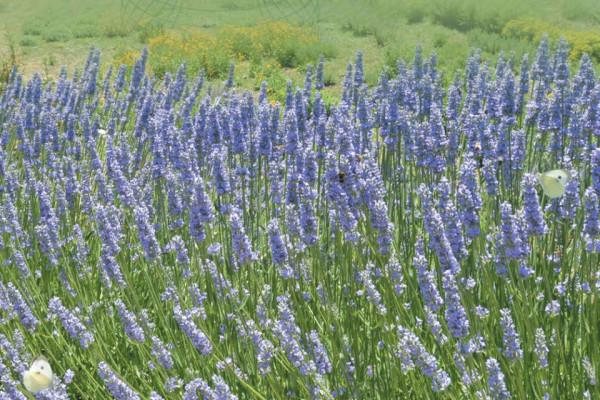

Lavender varieties
These varieties are both highly aesthetic and contain many aromas and essential oils. In room culture, the varieties Royal Crown, Blue Cushion (pale purple), Blue Ice (light purple), Christiana (blue-purple), Havenly Angel (white) are great.
Lavender varieties
The upper petals, like a tuft, above the head of the flower give the impression of an exotic plant, many varieties of Stehad lavender are two-colored: Fatehead is a dark blue spikelet with a scarlet tuft, Rocky Road is a purple spikelet with a pink tuft, Tiara is a blue spikelet with a white tuft, Kew Red is a bright red spikelet with a white tuft, Lilac Wings is a purple spikelet with a pink tuft. Monochromatic varieties are no less beautiful - Helmsdale is red, Snowman is white.
See also
Rules for planting and caring for aquilegia in the open fieldRead
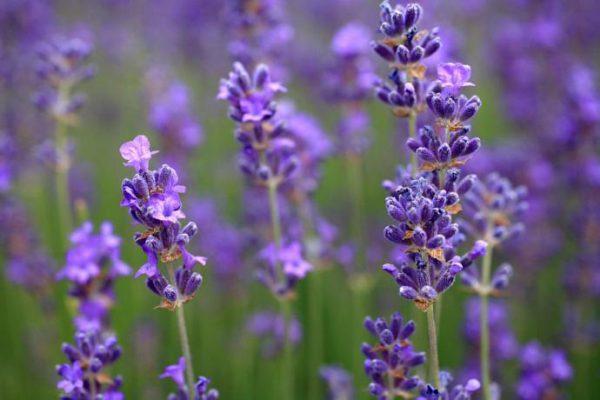

Disease and pest control
More often than others, the plant is affected by the fungal disease late blight. Some, and sometimes all of the stems acquire a slightly brown tint, many of them die. Rot is then formed near the roots. To avoid such consequences, the substrate is checked for diseases. Sometimes the disease is attributed to the condition of the parent plant. For the prevention of late blight, you will need to control soil moisture. Treatment is carried out with special means: Biosept, Mildex, WP, Aliette, Previcur. Sometimes bushes get sick with gray mold and septoria. In the second case, it is recommended to remove diseased shoots and clean the plant. Topsin and Amistar are also used. Euparen, Teldor, Rovral Flo are effective against gray mold. Among the pests, the most dangerous are the chrysanthemum nematode, drooling penny, caterpillar and aphids. Chemicals are used against them. Effective protection against aphids is possible if there are no nests nearby.
